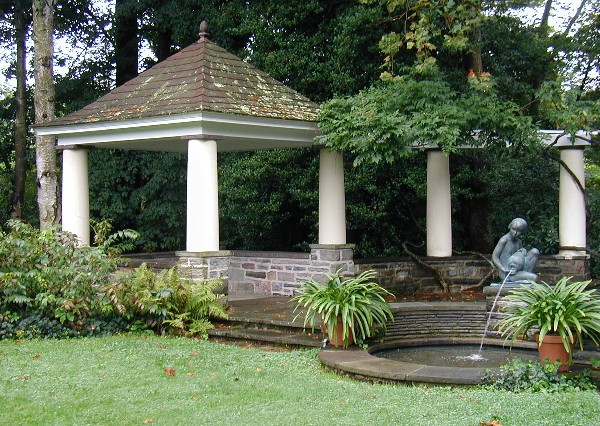
.
Paul once asked me if the members of the Garden Writers' Association were writers afflicted with gardening, or gardeners afflicted with writing. Something of both, I think, since we're passionate about plants, and also about getting the word out: writing books and brochures, magazine articles and newspaper columns, photographing plants and gardens, teaching classes, talking on the radio and performing on television programs.
We talk about the iniquities of contracts, the vagaries of the publishing business, and editors with their blue pencils (at least it used to be blue pencils, now it's the "delete" key on a computer keyboard.) But not too grumpily, because editors and publishers are also members and besides, without them we'd be writing to ourselves.
Every now and then we get together for regional meetings. And once a year there's the Annual GWA Symposium. There are talks, a trade show of plants and horticultural products, and tours of gardens both public and private. This year, 2006, it's the 58th Annual GWA Symposium, held from August 25th through 28th, in Valley Forge, Pennsylvania.
Is anybody singing? I couldn't say. I do know that most folks left early on Tuesday, once the symposium itself had concluded with the lovely dinner at Chanticleer. Some stayed for the post-conference tours to the brandywine Valley, or northern Philadelphia, or the Lehigh Valley and Allentown area tour that I went on. But then there was the die-hard, 'tisn't over til it's over, bus-load worth of garden fanatics who joined the Progressive Women in Horticulture outing organized by Plant Lovers Discovery Tours� and sponsored by the Valley Forge Convention and Visitors Bureau. Sharon Lee put together a fantastic program with its focus "on the visionary women of the first decades of the 20th century, who gave birth to the garden club traditions and laid the groundwork for horticulture as a profession for women and on the women who followed in their footsteps and created some of North America's finest gardens."
Our first stop is at Temple Ambler, the site of the Pennsylvania School of Horticulture for Women. Its goal of training women for carers in agriculture, horticulture, and landscape design was a radical notion when the school was incorporated. Founded by Jane Bowne Haines, who purchased the 71 acre grounds of the McAlonan farm on Meetinghouse Road near Ambler for the school in 1910, she declared that "The trained hand with the trained mind means mastery, power, and success." The very first classes were held in the farmhouse on February 11, 1911. Emphasis was given a practical, learn by doing, outlook. Women were taught botany and chemistry, but also hands-on pruning and bee-keeping. During World War 1, the school offered classes for the Women's Land Army.
Louise Carter Bush-Brown, herself a graduate of the program, directed the school for nearly three decades, from 1924 to 1952. Together with her husband, faculty member James Bush-Brown, she wrote America's Garden Book, first published by Charles Scribner's Sons in 1939, reprinted, revised, and last published in 1984. James Bush-Brown collaborated with Beatrix Farrand, a renown landscape designer, in the design of the stately, English style perennial garden, created in the late 1920s. Very much a part of the designed landscapes on campus, it has been renewed, revised, and tended by successive classes of students. Farrand, one of the 11 founding members of the American Society of Landscape Architects (and the only woman), is better known for more major projects such as the Bliss family's Dumbarton Oaks in Washington, D.C. and the the Harkness summer home Eolia in Waterford, Connecticut, currently preserved as Harkness Memorial State Park.
In 1958 the enlarged 187-acre campus was acquired by Temple University. Today Temple Ambler offers four year baccalaureate programs in Landscape Architecture and Horticulture, accredited by the American Society of Landscape Architects.

A pair of garden shelters, linked by a pergola and enhanced with a simple pool and boy with dolphin fountain create a destination and strong visual finish at the paired borders far end.
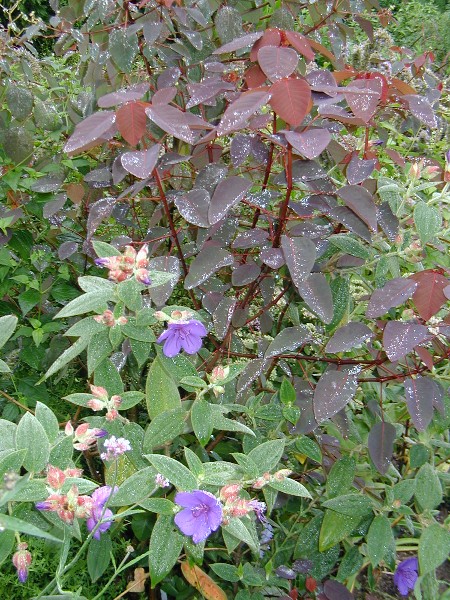
Like tiny moonstones, water droplets bead the purple leaves of Euphorbia cotinifolia elegant in partnership with Tibouchina's purple flowers. Temperennials, both will succumb to winter.
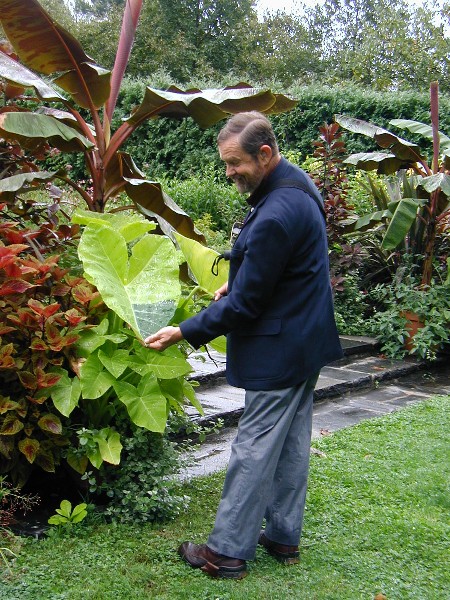
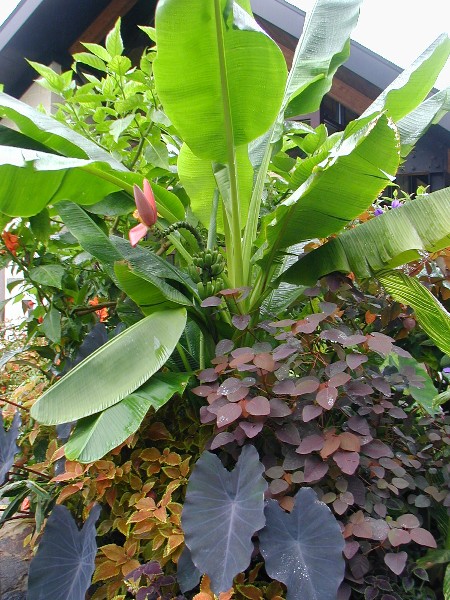
Elsewhere on campus my attention was caught by this banana in bloom, its lush foliage and pink flowers a handsome complement to the copper / russet euphorbia, black elephant ear, and copper-hues coleus weaving through.
An 18th century mansion, in the 1920s the grounds of The Highlands were transformed by Caroline Sinkler into nationally acclaimed gardens. Briefly: first owned by Anthony Morris, who had a Necessary built in 1794. The mansion took two years for its construction, completed in 1795. He planned an elegant farm, incorporating innovative ideas such as crop rotation, and raised livestock to make use of the 200 acre property.
In 1808 the now 300 acre property was sold to Daniel Hitner, who in turn sold the property to Philadelphia wine merchant, George Sheaff, in 1813. The family would live here for the next century. By 1844, landscape architect Andrew Jackson Downing described The Highlands as "a striking example of science, skill and taste, applied to a country seat, and there are few in the Union, taken as a whole, superior to it." A thorough appreciation of The Highlands history can be gained from written records such as Anthony Morris' very detailed account book and the Sheaff family's observant and thorough diary entries.
Two years after the death of the last Sheaff heir, and though house and property had deteriorated, it was purchased by Caroline Sinkler in 1917. Under her ownership the property regained its elegance, in 1933 receiving a gold medal from the Pennsylvania Horticultural Society as a mark of the garden's excellence.
Today The Highlands is very much a restoration work in progress. Using historical photographs, letters, and other documents the character of Miss Sinkler's 2-acre formal garden will be restored to its glory days of 1925 to 1935. Working with Doell & Doell, garden historians and landscape preservation planners, work has begun in 2001 with the restoration of the screening wall at the east end of the garden.
Newly planted, the boxwood will grow into hedges that further emphasize the garden's structure, rather like the house, with four principal rooms around a central hall.
The Morris Arboretum of the University of Pennsylvania, now the official Arboretum of the Commonwealth of Pennsylvania began as the elegant, eclectic, Victorian landscape of Lydia Thomson Morris and her brother John Thomson Morris. Lydia and John travelled the world, bringing seeds and plants back to Compton. In 1925 Lydia approached the president of the University and offered an endowed public garden, research and teaching institution, to be administered by the Botany Department for her trustees. It was not just the gift of the estate but in addition the bequest, that clearly illustrates the Morris sense of stewardship, of care-taking.
This elegant balustraded wall borders the rose garden, something Lydia had installed in 1924, almost a decade after her brother's death. Replacing an earlier kitchen, herb, and cut flower garden, beginning at its inception the rose garden has been highly regarded. It is not a rose-only garden, though they are the centerpiece. Perennials and herbs such as lavender embellish the beds and borders where grow the eponymous blooms.
It is not a greenhouse sinking into the ground. Rather, it is a fernery, a glasshouse designed by John Morris especially for the growing of ferns. The only remaining freestanding Victorian fernery in North America, the Dorrance H. Hamilton Fernery was built in 1899.
Across from the fernery is a stumpery. No joking. A stumpery is a pile of stumps. Prince Charles has one at Highgrove. First created in the mid-1800s during the British Romantic Movement, an artistic pile of stumps has its voids and pockets filled with leaf mold and soil where one grows ferns. I may have to try this at home in BelleWood Gardens . . .
The house is lovely, a Georgian mansion built around 1730 as the home of James Logan, secretary to William Penn. The three acres that remain with the property today are a scant remnant of the 500 acres of its heyday. In 1911 the National Society of Colonial Dames (who have administered Stenton 1899) decided that a historic house deserved an historic garden. Accordingly, a colonial revival garden was laid out by John Wister, appropriately enough a descendant of James Logan. Stenton is the site where the first meeting of the Garden Club of America was held.
There is, traditionally, an optional one-day post-conference garden tour. With options. I chose the Lehigh Valley and Allentown Area as A) it included three private gardens and B) I've already been to three of the five stops on the option 1 tour, as well as two of the four stops on the option 3 tour. Nice when we are offered easy decisions. So yet again the day begins, up and on a bus. The weather is not actively raining but it surely is, to use an Irish term, "soft" -completely overcast with a suggestion of moisture in the air.
The first garden is that of Scott Rothenberger. He refers to it as a contemporary farmhouse bungalow. As a first time homeowner and designer at Joanne Kostecky Garden Design Scott had to balance that tightrope many of us face: champagne tastes and a beer budget. He made it work, and work beautifully.
Though not huge, the house functions as a much larger building, blurring the line between indoors and outside. Every room except the guest bedrooms has glass doors which, on the main level, lead to a spacious deck. The space beneath the deck is beautiful living space, not storage for old bicycles and a leaky canoe. White walls, three large, white bladed fans, and a delightful garden just a step or two away create an inviting space.
Plants are carefully selected and beautifully combined. Shrubs, perennials, ornamental grasses, and annuals mingle in profusion. Notice the houses in the fog. These are Scott's neighbors, for his house is in a development. First on the street, his property has a larger yard than the others because it includes the retention pond area. Wildflowers encircle the area, and a turf path offers a means to stroll and enjoy what's now a beautiful view.
As well as gardens in the ground, Scott creates gardens in containers, grouping plants within large containers and arranging containers with containers. Curly willow swirls from the largest pot, accompanied by coleus at its feet, and sedum - still in its early, apple green broccoli stage - nearby. The willow will clearly have to move on.
Another cluster of containers gives a nod to the seasons - summer's end embellished with an ornamental cabbage, 'Magilla' perilla, catmint, Pennisetum setaceum 'Rubrum', and a couple more pots of sedum.
First there was an Olympic-size concrete pool. In-ground. And it leaked. So the concrete was dug loose, put back in the hole, compacted, and tons and tons and tons of soil were brought in to create a six-foot hight mound. We're talking a 21-foot change of elevation from the pool's bottom to the mound's top. Sculping of the soil, creation of an ornamental koi pond, a little waterfall, a Zen style dry garden, fascinating plantings include such delights as rarely seen and difficult to obtain sweet fern, Comptonia peregrina, a native shrub with aromatic foliage that may be used to brew tea. Completed as a multistage project over the course of a couple of years, the Grossinger garden is a Joanne Kostecky Garden Design project.
A fieldstone path skirts the linear border of lirope which frames the dry garden. The rocks were individually hand selected and carefully placed. A typical garden rake was reconfigured for use in creating the "waves" in the gravel sea.
The third garden (and another Joanne Kostecky Garden Design) appears from the street as yet another typical oversize house in a new development. This project had to cope with a steep slope at the rear, coupled with some spring-fed wet areas.
Notice the calm placement of a sweep of grasses, in this instance Pennisetum alopecuroides, so well grown that even the morning's moisture does not flatten it. Inclusion of both evergreen and deciduous shrubs provide both seasonal appeal and winter interest.
Underplanted with Mazus reptans, a copse of Winterberry Holly, Ilex verticillata, will take center stage when its leaves drop and berries turn sealing wax red, remaining through winter to lend sparkle to the season.
We'd picked up our box lunches and eaten as the buses cruised down the road to Maxatawny township, near Kutztown, Pennsylvania, where The Rodale Institute and Farm is located. A 333-acre working farm, they grow corn and soybeans as two of their cash crops. The fields may look weedy, but in this year's severe August drought the crops were less affected than in neighboring farms using non-organic methods. "It's all in the soil." we were told. As well as producing crops the farm conducts research. Accurate records are kept of field trials on commercial scale, allowing comparisons to be made between traditional methods that rely on fertilizers, herbicides and pesticides, and the organic techniques the farm is noted for. Next year, 2007, will mark the 60th anniversary since J.I. Rodale founded The Rodale Institute, to scientifically prove his philosophy of "Healthy Soil = Healthy Food = Healthy People�." Foremost among the Institute's goals is to promote and encourage the use of humus and other organic matter in order to maintain and improve soil fertility, prevent soil erosion, and improve human health.
In addition to the multi-acre farm fields there is a demonstration garden where flowers and vegetables grow, mingled together in raised beds. Composting for the garden takes place in compost bins. Additionally, the beds are mulched with grass clippings, readily available every time the turf is mown. Not only does it make a great mulch, it helps to control weeds and conserve moisture, as well as enriching the soil as it breaks down. The grass clippings are spread straight from the mower�s collection bag onto the garden plots.
Chemical fertilizers are not used, nor are any animal-based manures. All the garden scraps and weeds eventually end up in one of the 10 composting bins where they're allowed to break down before being spread back onto the beds, between crops. This compost is the only nutritive substance added to the soil.
Something more is needed for the farm fields. Windrows of decaying organic matter from autumn leaves to wood chips and grass clippings goes into huge windrows. Delivered by commercial haulers who collect from municipalities, the material needs to be turned. The Rodale Institute designed this nifty machine that straddles the pile and efficient stirs and aerates it.
Organic matter is important in the development of a soil with good tilth. One look at this carrot from the demonstration garden, not merely long and large but also nice and straight, reveals that there's no rocks, roots, heavy clay, or other carrot-deforming material in this garden.
It started to drizzle and I ducked into the nearby open-sided education center. There was even a sweet cat to cuddle. Jolie and her sister Angelina were found on the road as stray kittens. They're working members of the Institute, housed in the greenhouse where they control the rodent population. And, just like the rest of the staff, very people oriented.
It was fortunate that our last stop of the day was an indoor venue, at Campania. Selling only wholesale and to the trade, their garden art and decorative containers are elegant, charming, and in many instances made right there on the premises. So meticulous is their work that their product line includes pieces based on examples at the Morris Arboretum, Longwood Gardens, and the firm is now working with the Smithsonian. Just imagine going into the storerooms of the Nation's Attic and rummaging around for containers, plinths, urns, and statuary to reproduce. What fun! But it is more complicated than you might think.
A mould from which the casting will be made must be created. Since the mould material is flexible, it must be supported by a rigid form. This sample is a plaster casting of a pineapple, and it is quite crisp and clean. But a mould may only be used for a finite number of times (variable, with the complexity of the casting and the material used for the casting) and the mould wears out, the lines of the casting becoming blurred.
Here, concrete containers, good size flower pots, must sit until firm enough for the forms to be removed. Each had been created on a low vibrating table, actively shaking the piece as its filled to eliminate air bubbles which would weaken not only the integrity of the piece but also create unattractive voids and small pockets on its surface.
Campania has a staining technique for its pieces, a preferred method as the color actually sinks into the surface, better than a surface finish which might weather away or become chipped and discolored. Each finishing line uses only a single color. As an order is pulled, one worker applies the color to all the pieces. That way the "hand" will be uniform for a more harmonious result for the pieces.
The color is not simply sloshed on and considered done. After the stain is generously applied the piece will be wiped down. This avoids an artifically uniform surface appearance,
as stain is reduced on the raised surface of a design and more color remains in the recesses.
The showroom is filled with a plethora of pots in all imaginable sizes and styles from ornate to simple, contemporary and vintage, classical and playful. Something for every garden whether city or country, large or small, casual or cottage or formal. Now if they had only plant edsome up for a livelier display . . .
Back indoors for the afternoon's several concurrent sessions, refreshment breaks, more concurrent sessions. I confess to playing hooky. Some down-time was very much needed. I wanted to be refreshed, vivacious, and ready for the evening's events at Chanticleer. And what an event it turned out to be, meeting all expectations and then some - splendid gardens at their summertime peak, delicious food, rolling landscapes, locally brewed beer and wine to quaff, a tour of the house, wait staff circulating with trays of appetizers, permission to swim in the pool (with bathing suits and towels provided, of which I availed myself), musicians playing in the ruins, food and fun and flowers and friends - oh my!
Rough surfaced granite steps lead up to a terrace. The arbor, though open to the sky, offers an intimation of shelter. Casual pockets of flowers - tall liatris and warm orange cosmos - suggest this is the remains of a structure now returning to nature.
Everywhere my attention is captivated with the attention to detail. Surely designed by a hobbit, an arched handrail whose gnarly / knob-like base appears to grow out of the bridge.
Music provided by the Gerald Benson trio: cello, guitar, and drums. Jazz in the ruins, and Gerald has a mellifluous voice, like warm honey poured over the chords. Changed the ruins from somber to sophisticated. Lovely.
Today was supposed to start with an eager beaver early morning photo shoot, departing for the Morris Arboretum at 5:15 a.m. It was, fortunately, an optional event. Of the 110 who signed up for it, somewhere around 4:30 a.m. most of them must have looked at the dark, dank, overcast morning, rolled over, and gone back to sleep. Kudos to the 19 who actually boarded the bus. here's hoping they all got some spectacular images.
The rest of us boarded buses at a more reasonable hour for what's called story tours, visits to gardens that inspire us to write about them. Today's concurrent sessions would be held in the afternoon.
The next garden could easily have entertained us for hours and hours. From the moment I stepped off the bus until I was reluctantly shooed back on again there was always something fascinating to see. Island beds set in the lawn, with carefully composed, immaculately maintained plant groupings. I never got to see the award-winning three-level conservatory, didn't count the water features so I'm not sure I saw all seven. But what I did see was a matter of pleasure and delight.
When I was muttering about too little time, I was asked if I'd rather have longer in two gardens or less time and see three gardens. No hesitation. "Two." I said firmly. But this one? This one I want all alone. And all day.
Third of our morning's garden-hopping outings, the buses wind up a tree-shaded country lane passing horse pastures. We're unloaded from the bus to walk the last portion and arrive at Fox Hollow. Inta Krombolz is an artist welding graceful sculptures from discarded machine parts, which are then colored (but whether painted or enameled or some other technique I am not certain) to blend with the garden beds and borders where they are incorporated. Her artist's eye is also evident in the garden's fabulous use of color - purple foliage and flowers mingling with apricot and orange flowers, the simmering brew soothed with silver foliage. The house and its garden are on separate levels, with the house up by the road and a gentle slope behind it leading down to the garden and a marshy streamlet at its back.
Purchased by Pierre du Pont in the summer of 1906, the land near Kennett Square, in Chester County, Pennsylvania that has become Longwood Gardens this year celebrates one hundred years of garden splendor. Known to an wide array of gardeners - those who visit regularly, others who make a memorable single pilgrimage, and those who are planning to arrive at this iconic garden"sometime," Longwood delights both the avid gardener and the more casual visitor with more than mere rarities, displaying ordinary plants grown exceptionally well, beds and borders bursting with color, demonstration gardens, a conservatory that a garden under glass, and much, much more.
Garden writers who had never been here before took advantage of a bus departing early from Wilmington's walking tour, providing additional time to view Longwood's horticultural riches. Having had the good fortune to visit on several previous occasions, I was content with a later arrival. Once there, I remained within the conservatory, enjoying its elegant renovations and the summer splendours of the water garden that shelters in an enclosed courtyard.
Sponsored by Longwood Gardens, we're invited here for a gala reception, dining and dancing and fireworks, celebrating Longwood's 100th anniversary. And do they ever know how to throw a party!
After dark we went outside, for an absolutely fabulous music, fountains, and fireworks performance. The sky rockets in the night were the finest I've ever seen, a dazzling spectacular as sparkling throughout as others' finale. Then adieu, into the buses, and back to our hotels. I slept, delightfully tired from the day's multiple, wonderful events.
After the morning's concurrent sessions (including a very practical and useful writers' panel on Magazine Queries 101, sharing experiences, ideas, and suggestions of what works and what doesn't) we were - no surprise - again back on buses, clutching our box lunches and on our way to Wilmington, Delaware. Once we arrived at Trolley Square and Rockford Park neighborhoods in the northeast corner of the city, we were turned loose to visit five private gardens and a few historic public gardens. A small shuttle bus ran in a continuous loop, providing a time-saving transit between the furthest points. Having been given the advice that this was an � la carte tour, my decision was to go for the private gardens. After all, should I ever return to Wilmington the public gardens would always be accessible. So off I went, down the tree-shaded sidewalks and attractive homes in quest of the first garden.
You'd never know you were in the city. Enclosed by a brick wall, stately trees, a grand sweep of lawn, and a Tudor style house more than a century old combine to make this a serene and private retreat. (Of course, Sunday's reduced traffic added to the peaceful ambience.)
The next garden was more modest in size, with charming personal accents at every turn, such as a single decorative metal fence section mingled with shrubbery and guiding visitors down the garden path. One aspect I really appreciated: formal, rectilinear rose beds cut into the lawn and backed by the neighbor's low brick house appear part of the this attractive garden with flower beds in both sun and shade. What a pleasant partnership these neighbors have with each other.
Traffic swirls around this three-way intersection, embellished by a sun-loving mix of hot yellow, gold, orange, red, and lime green annuals and perennials. That's this year's theme colors, which have varied over the 20 years Mary Lou has devoted to this guerilla garden.
At home, Mary Lou's garden is quite different. Her townhouse just about fronts on the street, across from the traffic island. The modest garden is in back, and is mostly shaded, thus a very different situation. Six years ago she improved the site, double digging and adding peat moss, composted mulch, cow manure, and sand. There's an impressively tidy tool shed at the rear, a deck and small patio of the back of the house. And between the two are paths, small trees, herbaceous perennials, and funky, colorful garden art, much of it by local artists.
Presenting a rather modest face to the street, then a narrow path around to the back, and wow!
The backyard terminates with a gigantic spillikin of boulders. Rather than thinking it unsightly and wretched, Anne and Terry made it the focal point. A frothy skirt of impatiens, cleome on the left and some August lily, Hosta plantaginea, to the right, a crisply edged lawn, and the lichen-covered boulders enhance the garden scene.
I'm so glad that this was the last garden to be visited on my scurry around on the Wilmington Walking Tour. It speaks to my heart. Had I seen it earlier, my pleasure in the other gardens would have been lessened.
What a garden. Saying the site is challenging is an understatement. Formerly a granite quarry, many stones still display the drilling marks where pieces were split away. The house is up top, and the cliff-hugging paths wind down to the bedrock, uncovered when John began clearing soil away. Thomas Eddison said genius was 10 percent inspiration and 90 percent perspiration. So it is for this garden.
Rocks, I've decided, are always downhill from where you want to place them. This garden is no exception. Twenty-five years ago John and his father began hoisting rocks out of the quarry bottom and building paths. It involved engineering and the laws of physics, cables over the trees and the use of winches. All the stone, anywhere you see it in the garden, originated on site.
A garden I could come back to again and again. As snow softens outlines, leaves turn from green, drop and drift in the air, and tender spring green hazes bare branches. Rigid in its stone embrace, ever changing with the seasons, a garden of pleasure and delight.
Mention Peace� or Knockout� roses and there's instant recognition. But where they came from, and how they got to our gardens is often a different matter. Conard-Pyle has a nursery in West Grove, Pennsylvania, and another in Maryland. They hybridize roses, producing thousands from seed and rigorously culling not merely for beautiful flowers but also overall growth habit, attractive foliage, weather-proof vigor, and disease resistance. Founded in 1897, next year the company will celebrate its 110th birthday.
Star� Roses are not all that Conard-Pyle produces. Their Star� Plants include perennials, groundcovers, and shrubs such as the smaller, more compact Caryopteris Grand Bleu�, with deep blue flowers from August until frost, and a charming, compact Buddleia 'Peacock' that won't tower over neighboring plants, modest enough (4 feet by 4 feet after five years) to use as a container plant, without diminution of flower power and butterfly appeal.
Then it was out the doors, and onto buses, with box lunches to eat along the way to a most magnificent house and garden. Remarkable, considering that it looks very much as if it had all been lifted wholesale from the Cotswolds the house is new construction, set into beautiful rolling countryside.
The morning was taken up with an excellent keynote lecture by William McDonough, internationally renown for the quality and environmental sensitivity of his architectural designs, environmental sensitivity, and functional effectiveness. In discussing one design, he said that the buildings they design provide "life support systems for people who work, not work support systems for people who don't have a life."
Pithy sayings were used to make his points: Being less bad is not the same as being good. Once, when making a presentation at The White House, he was asked what he thought of clean nuclear power. His response: Gardens are nuclear powered. It's 83 million miles away, takes 8 minutes to get here, it's clean, it's wireless. What's not to like? Gardens, he continued, are solar income.
Coauthor of "Cradle to Cradle: Remaking the Way We Make Things", I was not the only one who regretted that copies were not available for purchase. Two concurrent sessions followed.
August has been dry. From the beginning of the month and right up to August 25th there'd been less than a half-inch of rain in my gauge. By the end of the month we're well where we should be, but if I knew who to talk to I'd have something to say about the distribution.
Accompanied by heavy rain, a tornado touched down overnight, practically in the parking lot of our hotel. As tornadoes go, it was minor. But we're not in Kansas, and Pennsylvania is not exactly Tornado Alley. So trees wrenched apart are rather more excitement than is needed.
A gazillion things to do before I leave. Remarkably, I was in my car and heading down the driveway at noon, scarcely two hours later than my original intention of a 10:00 a.m. departure. A simple 90 minute drive and I was there and checking in to the hotel. When you consider that the registration list of 662 people included members from the West Coast, the Midwest, both coasts of Canada, as well as locals and every place inbetween it's easy to see how happy I was with my drive. Dump the luggage in my room and head off for the trade show.
Fifty or more booths: familiar names such as Conard-Pyle, from Peace to Knock Out� a leading producer of roses for the last hundred years; Timber Press, publishers of so many great gardening books that one look at a gardener's bookshelf and you'd think they own stock in the company; Ball Horticultural Company, internationally renown plant breeder, producer, and wholesale distributor of such popular and familiar ornamental plants as Madness� and Wave� petunias; The Espoma Company, leader in natural organic plant foods and soil amendments since 1929: Campagnia International, Inc., manufacturer, distributor, and wholesaler of quality cast stone, terra cotta, fiberglass, and resin planters, pots, and garden accents. Others, perhaps less well known, were also there, such as "The Bulb Hunter," Chris Wiesinger, of Southern Bulbs who was up from Texas. And more, and more, and more.
From Virginia, Brent and Becky's Bulbs had a booth embellished with a beautiful bouquet of summer bulbs: crinum, amarcrinum, lycoris, and Mexican tuberrose.
In addition to horticultural "stuff", that is, plants, there were what you need to make it grow: fertilizer, watering devices, soil amendments . . . and tools. The Fiskars booth was especially popular, gardeners - opps, I mean garden writers - squeezing clippers, testing loppers on thoughtfully provided branches, and in general having a high old time.
The trade show is only open for set hours over two days, and never when there are meetings or garden tours. No playing hooky and hanging out around the booths.
And if all of this is not enough, jump over to Perennial Plant Association in Philadelphia
.
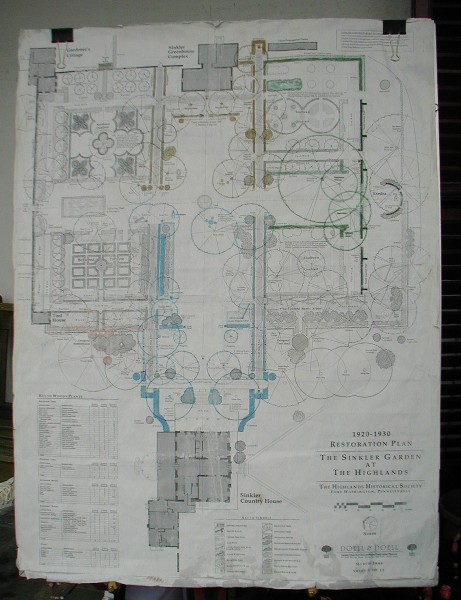
transmuted from lines on paper to plants in the garden.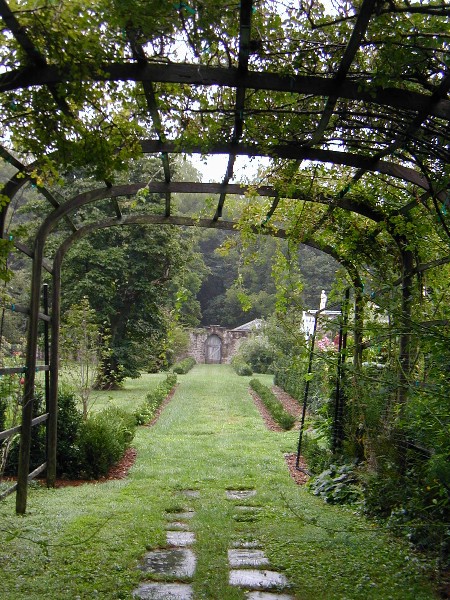
towards the brick wall that conceals the greenhouse.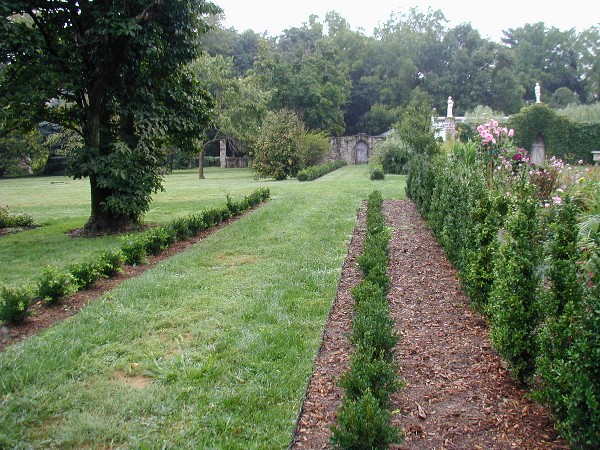
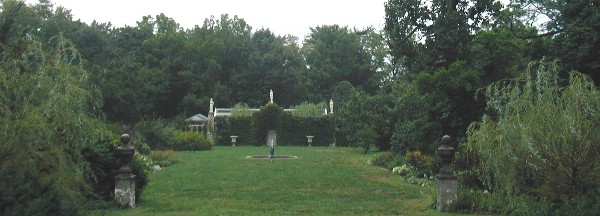
the center "hall" with its various urns, statues, and a fountain for the focal point.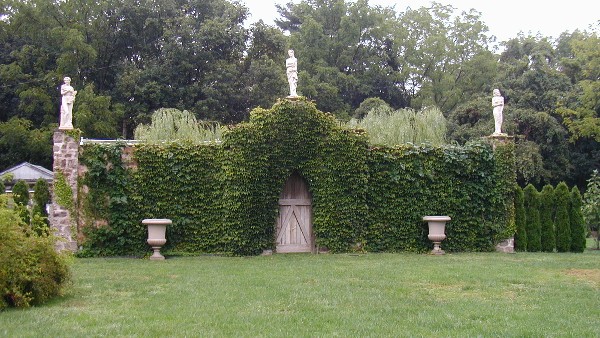
well endowed with nymphs and satyrs, heroes, gods and goddesses.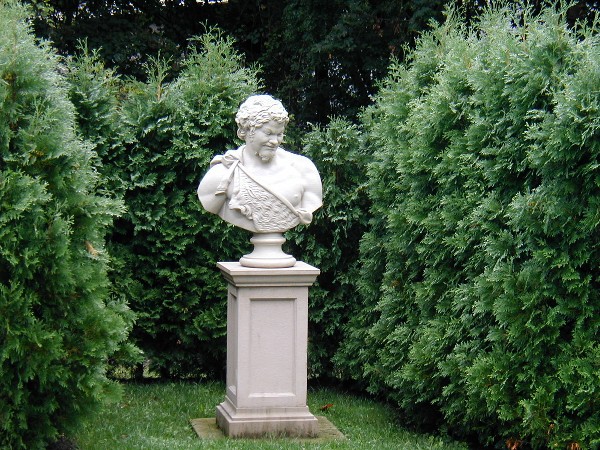
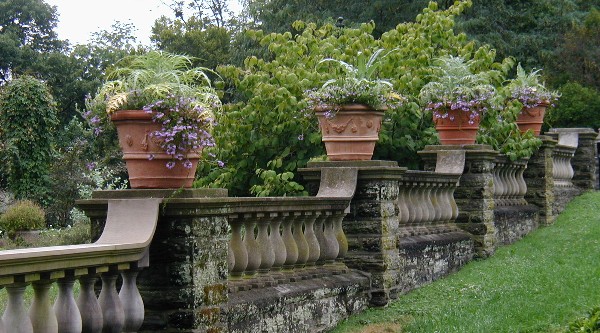
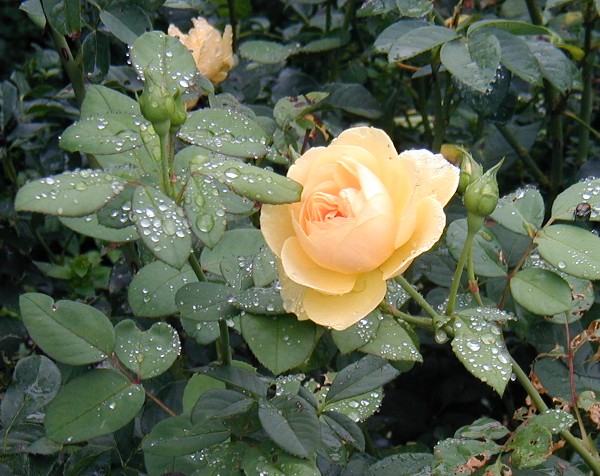
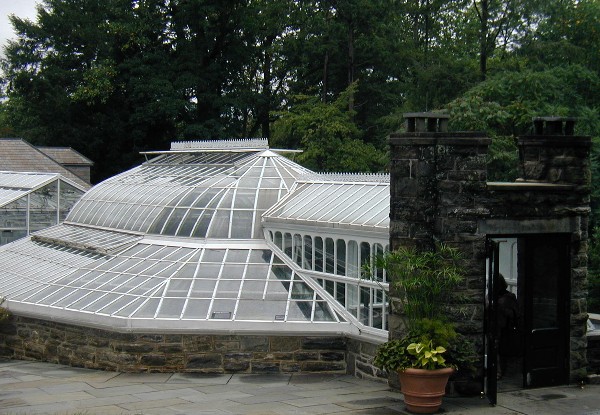
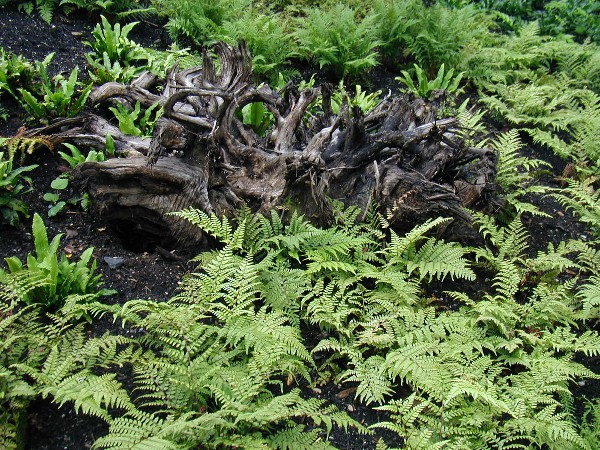
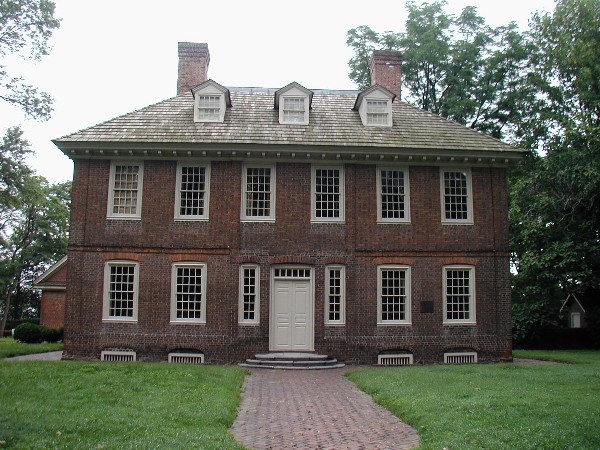
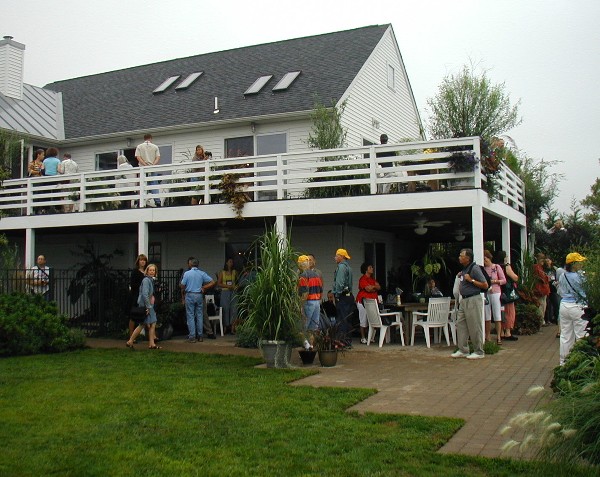
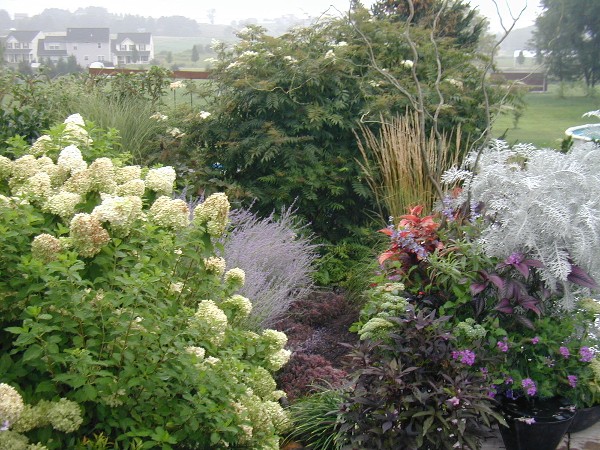
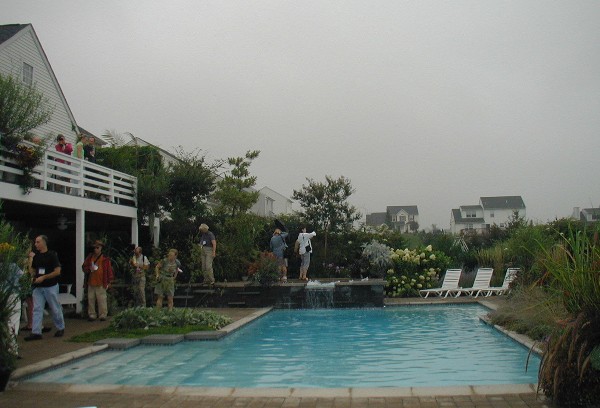
A custom shape (Scott's own design) makes the pool more than merely a place to swim. There's a spa with waterfall, and a careful play on shape and scale with three cantilevered pieces of bluestone, which is mimicked by the sawtooth intersection of hard pavers and and soft green grass turf seen in the first image. Small wonder that in February 2006 this pool landscape won second place among nearly 400 entries from Pennsylvania, New York, and New Jersey in a contest sponsored by Concrete Stone and Tile Corporation.
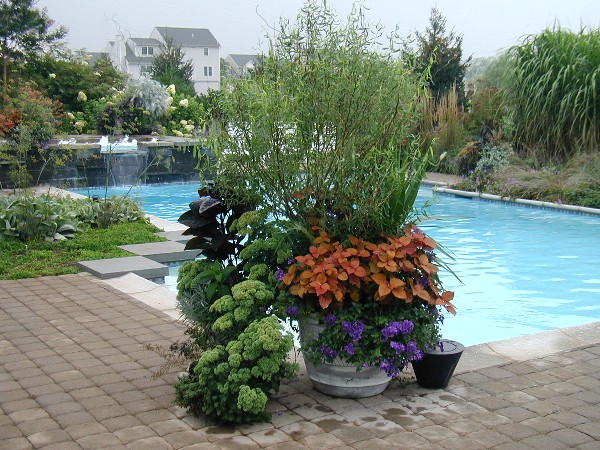
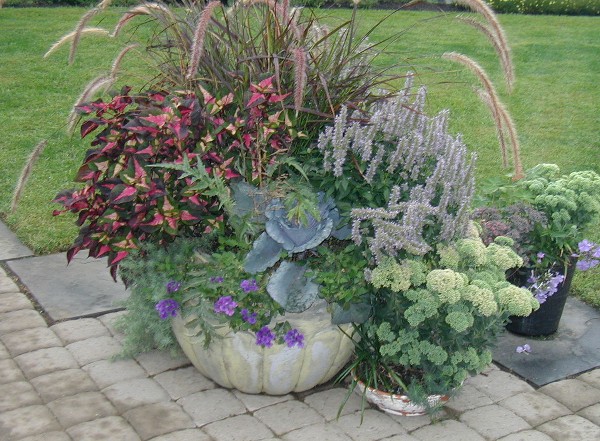
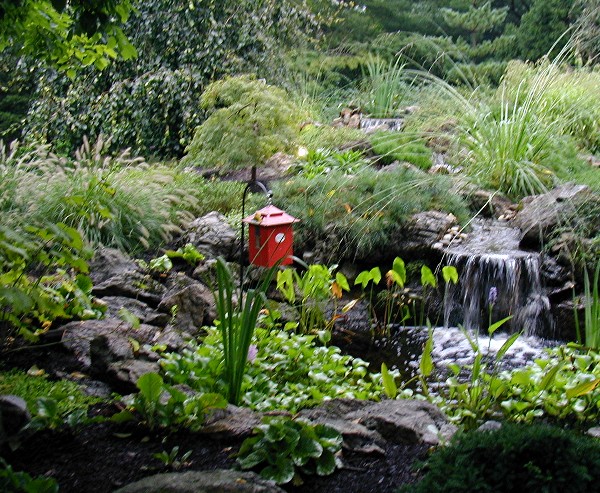
How nice when all the pieces come together in so tidy a manner.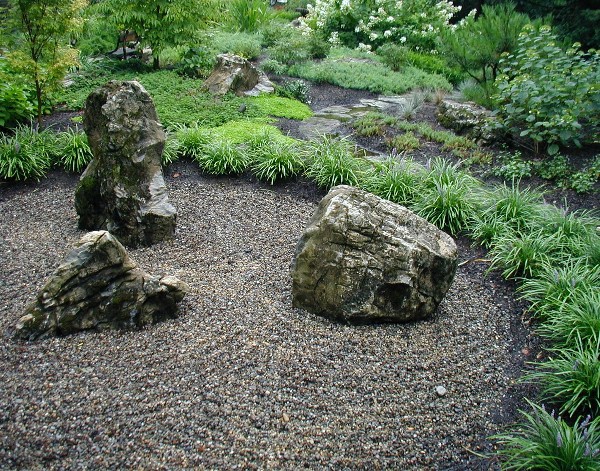
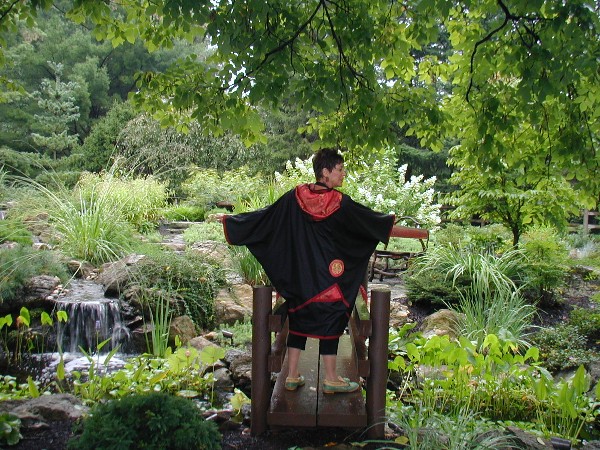
her raincoat appropriate for this garden's ambience.
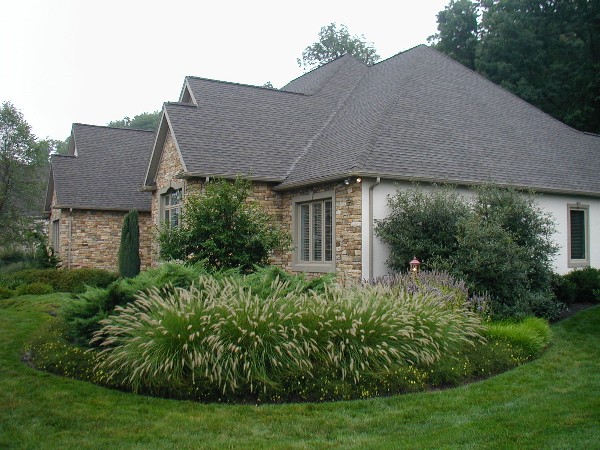
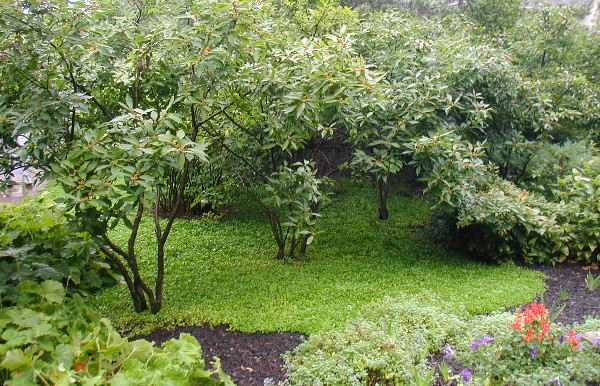
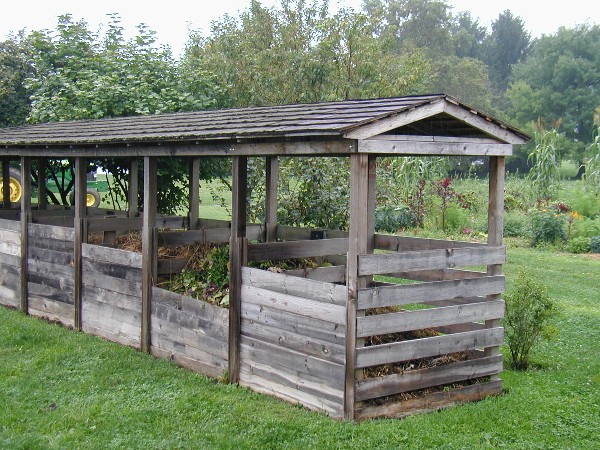
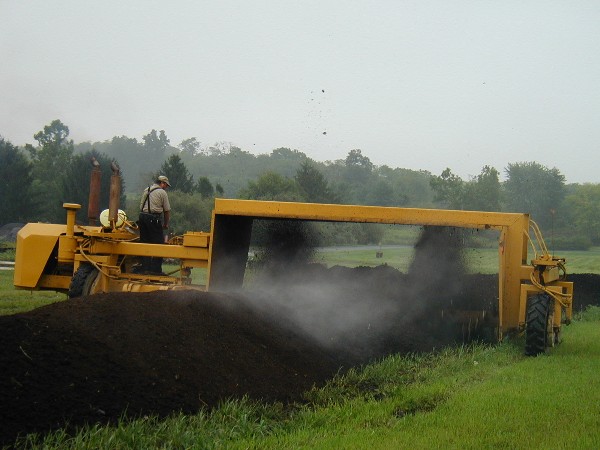
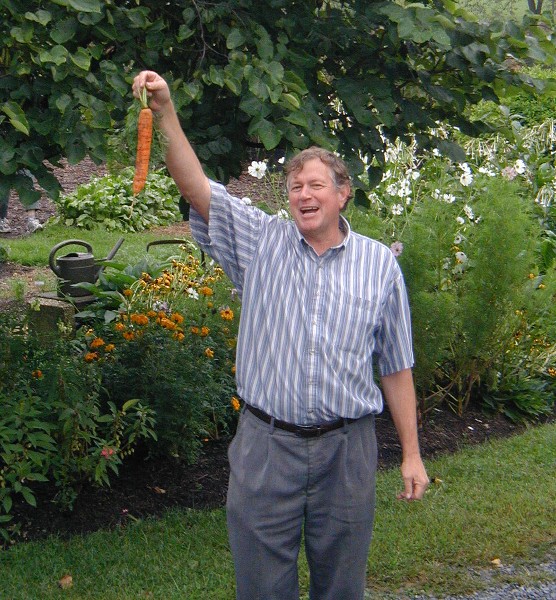
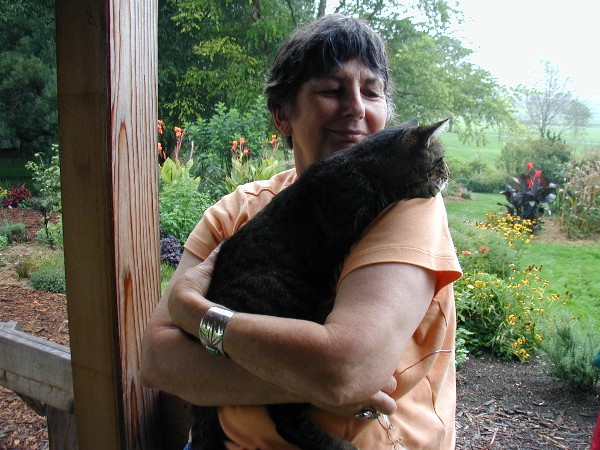
Photograph Credit Rick Ray 2006. All rights reserved.
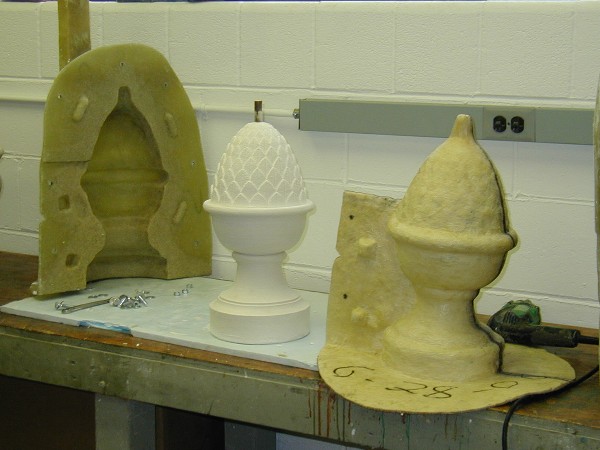
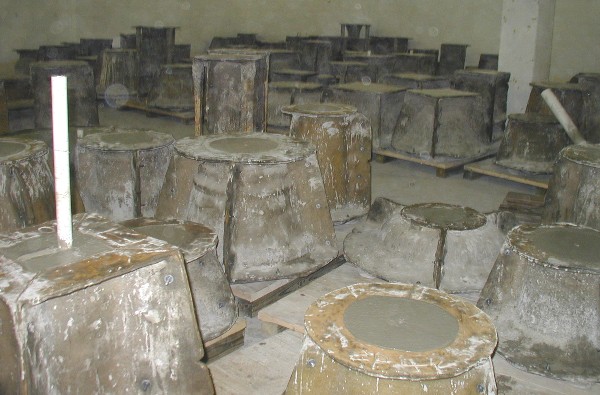
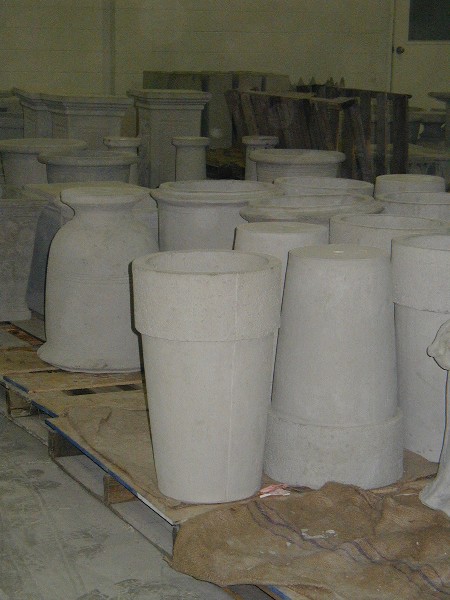
Concrete cures forever, it seems, gaining in strength and durability as time goes by.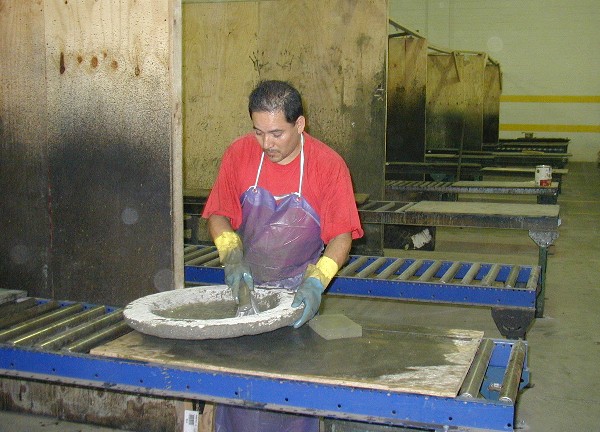


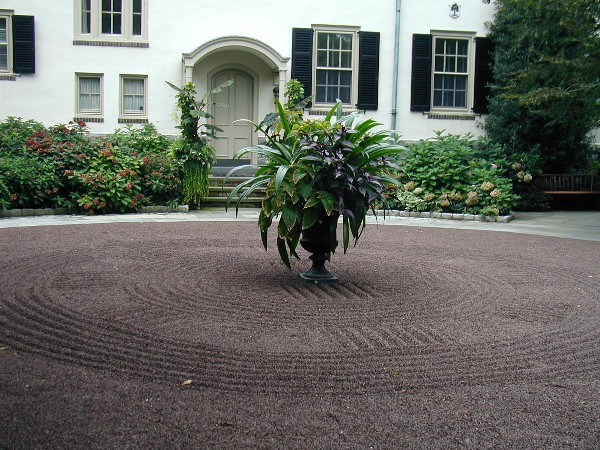
of the attention to detail that's a hallmark of Chanticleer.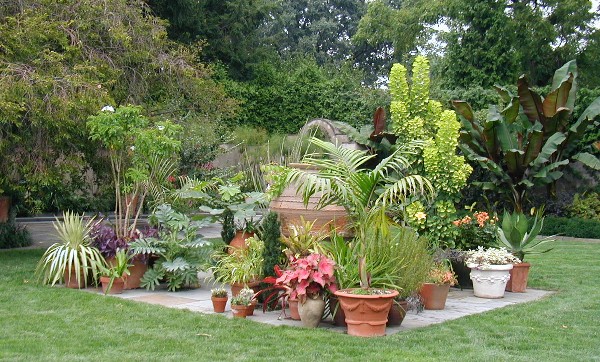
of green, pink, and purple embellished with a scattering of flowers.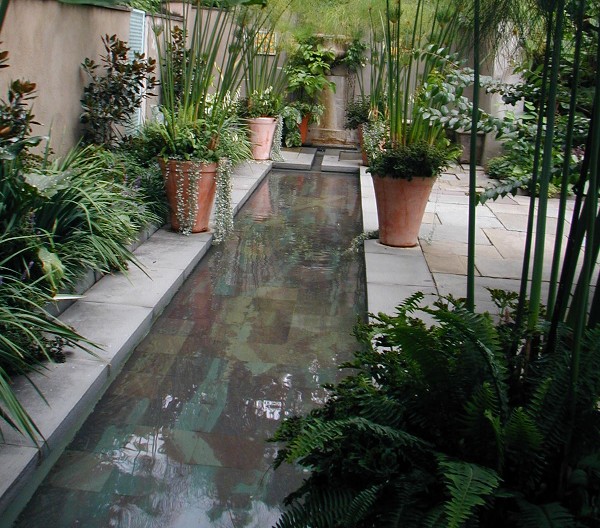
for the bottom accentuates a modest courtyard,
accented with tall pots of papyrus.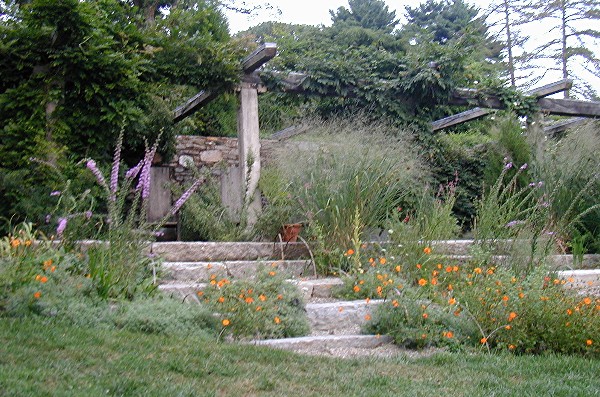
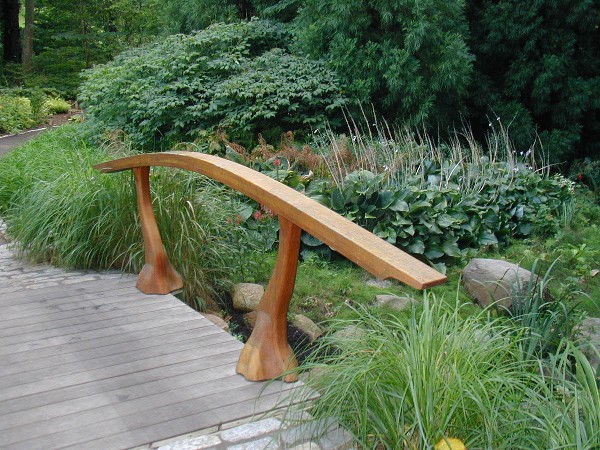
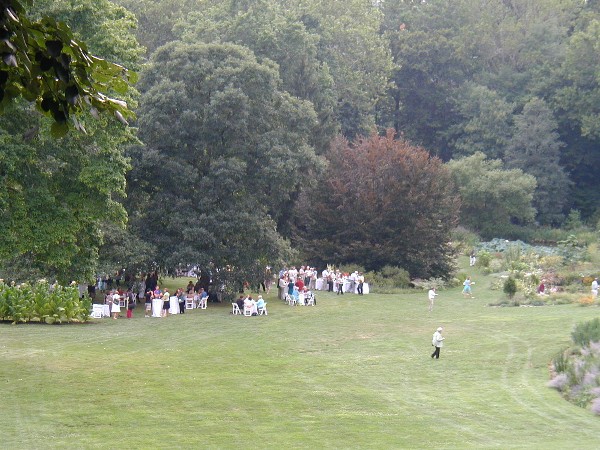
as we sample, then saunter off to admire the various gardens.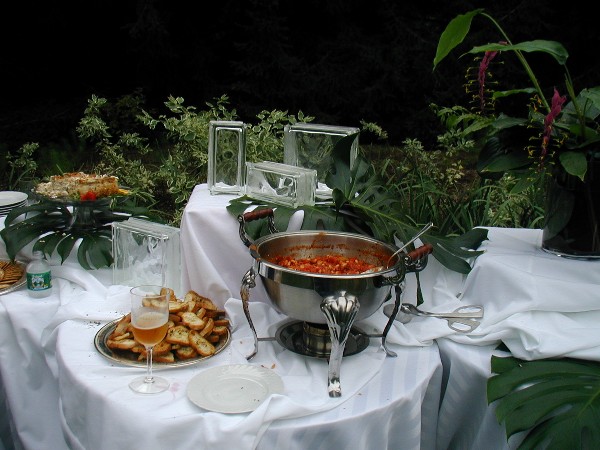
herb bruschetta. Just one of the delicious dishes available in the pond garden.
to make their award winning Hop Devil Ale.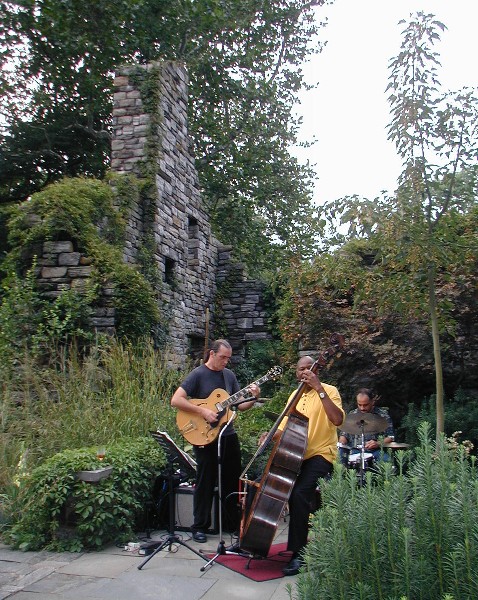
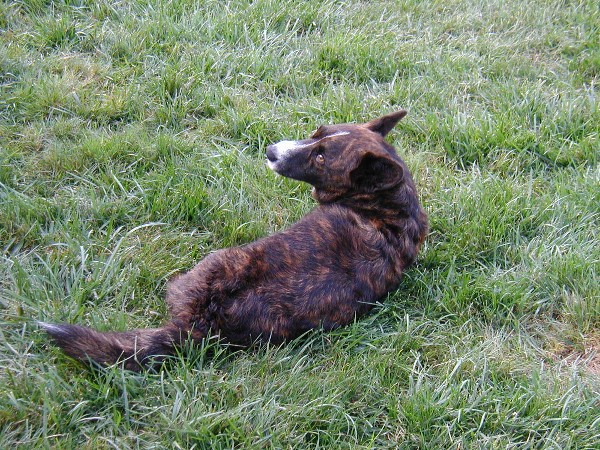
he took a well deserved rest.
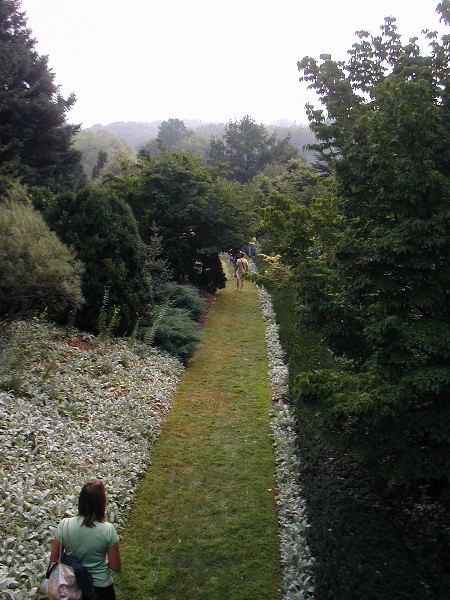
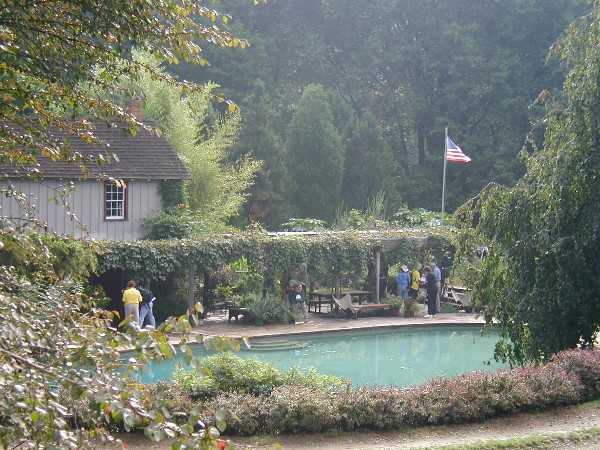
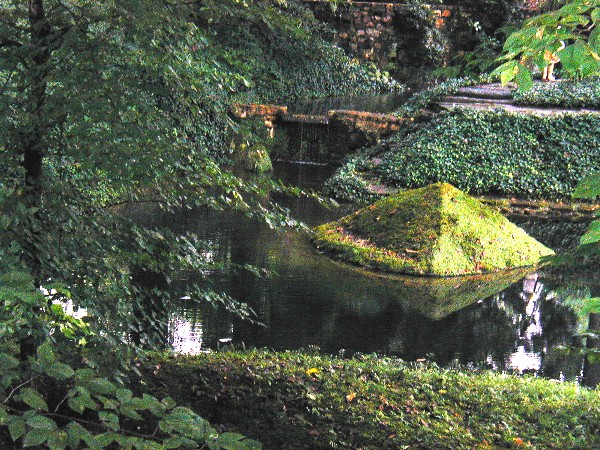
a moss-covered pyramid appears buoyed on the dark water.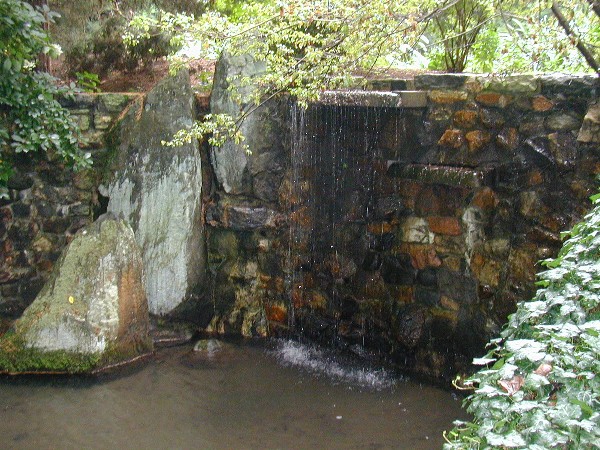
a waterfall musically cascades, the white lace of its frothy arrival in the pool distant enough
that the surface barely trembles by the time it reaches the pyramid.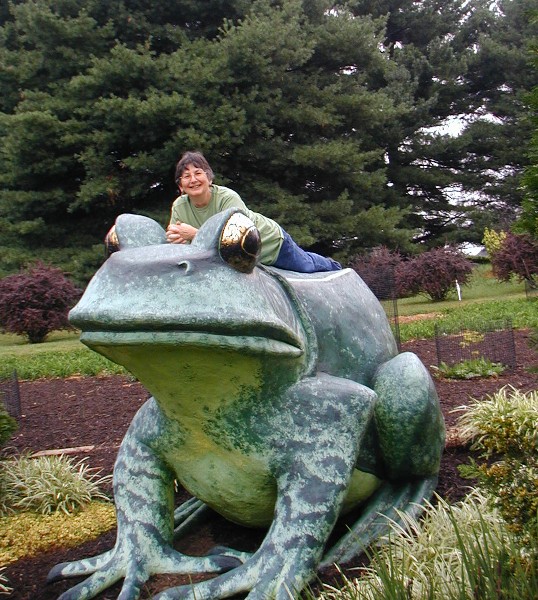
Photograph Copyright © 2006 Joe DeSciose. All rights reserved.
Sculpture by Linda Lee Strong, Lamy, New Mexico
He and I are very happy together.
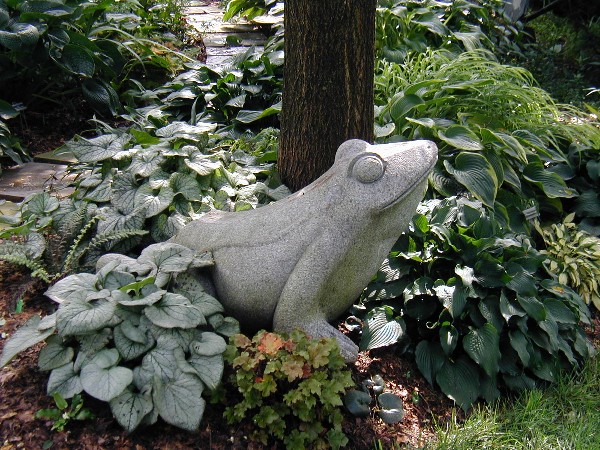


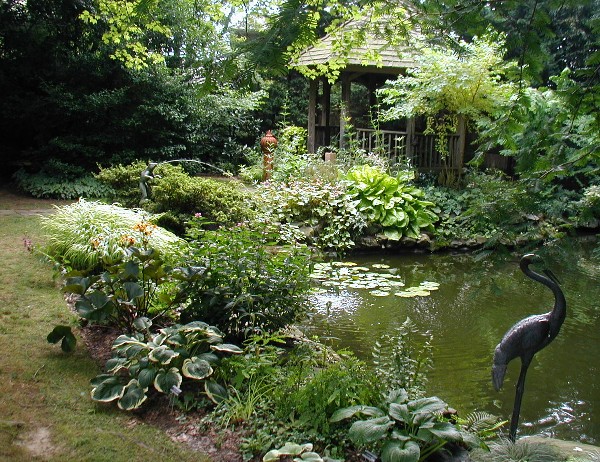
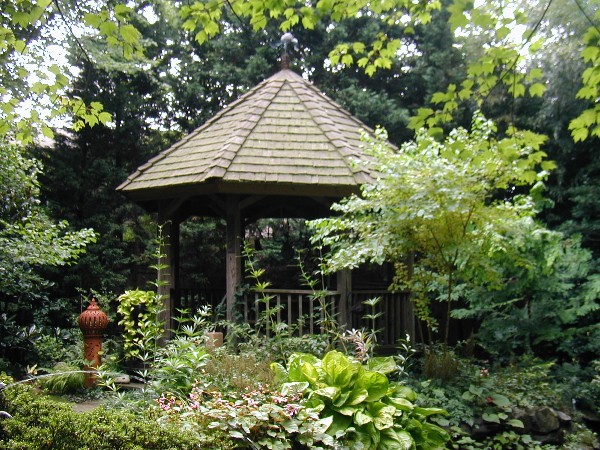
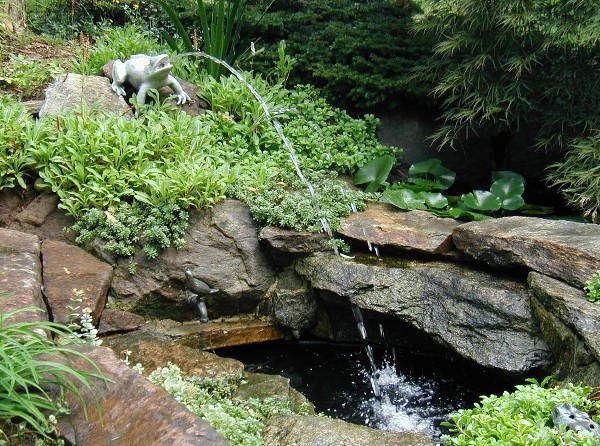
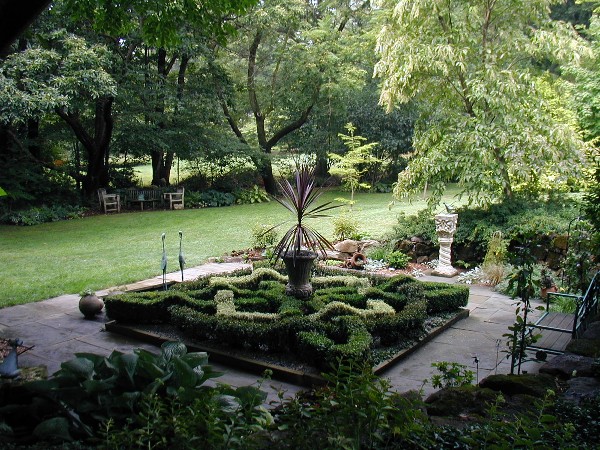
the triple hedging interweaving, flowing over, impeccably clipped in a tidy manner.
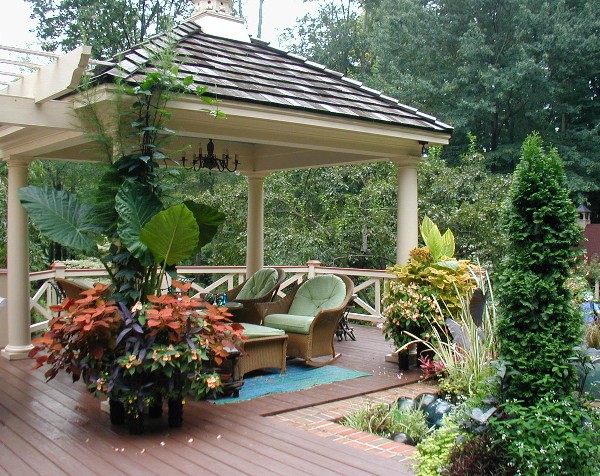
Lush container planting provide a tropical ambience.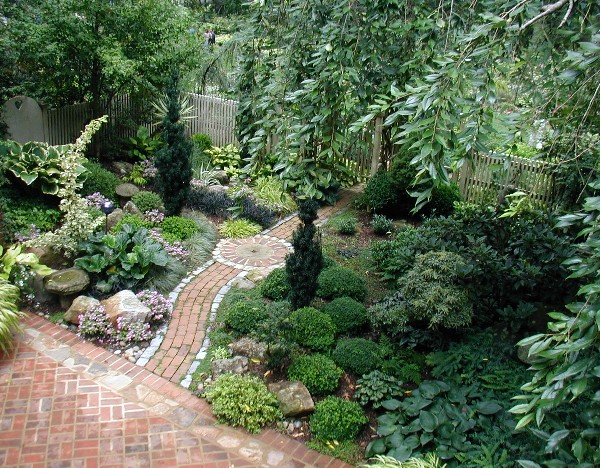
with tidy brick path, circular hub, and well-clipped little shrubs.
With a certain air of southern gentility and rustic deshabille,
this elegant potting shed seems rather small to be a functional structure
filled with bags of compost, stacks of pots, and a work bench.
Who cares. It's lovely.
the matching blue planter, and blue spheres set in the liriope.
Take a closer look at the planter.
It's made from a tire on its rim! then painted to match. Fabulous.
Look closely, and you'll see the deer netting on the property's perimeter.
Great combination of coleus (looks like 'Alabama Sunset') and 'Ace of Spades', a purple-leaved sweet potato.
It creates a color echo for the larger purple-leaved sand cherry off to the left,
and emphasizes the soft chartreuse foliage and pale orange flowers of begonia and salvia.
and functionally keeps mulch out of the lawn.
distinct and inviting, clearly intended for a slow stroll rather than a working expedition with tool-filled garden cart.
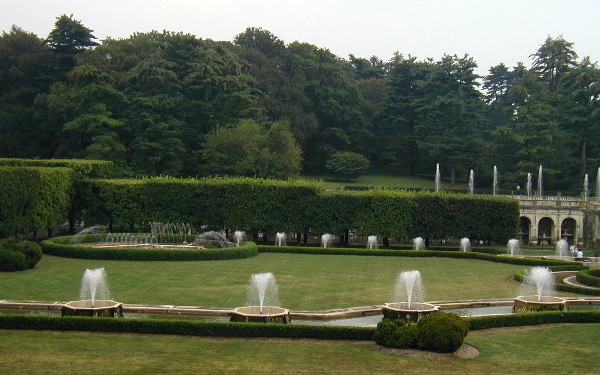
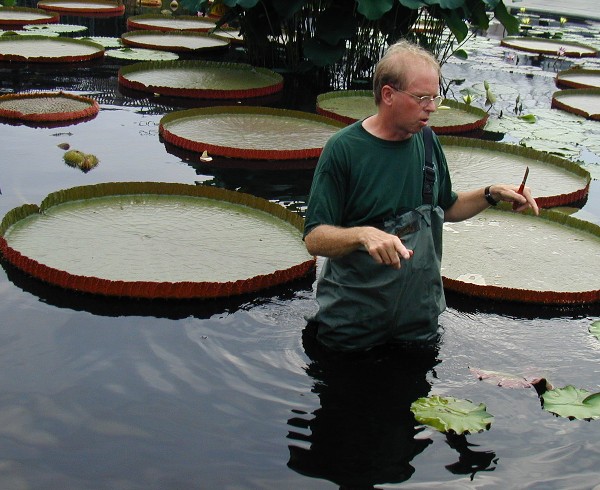
The floating, flying saucer-like leaves belong to Water-platter, Victoria 'Longwood Hybrid', a cross betweenV. amazonica and V. cruziana
Grown as an annual, seeds are started indoors in February, and planted outdoors at tomato planting time.
and can even support a child standing on one (provided weight is distributed with a board.)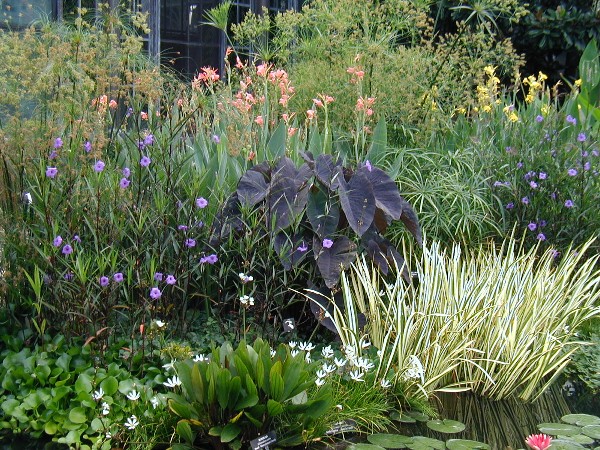
In the back are salmon pink 'Erebus' and pale yellow 'Ra' Longwood Hybrid Canna,
with lavender flowered Ruellia dancing before them.
the bold black leaves of Colocasia 'Black Magic', umbrella-rib leaves of papyrus,
and crocus-like white flowers of water-loving Zephyranthes candida.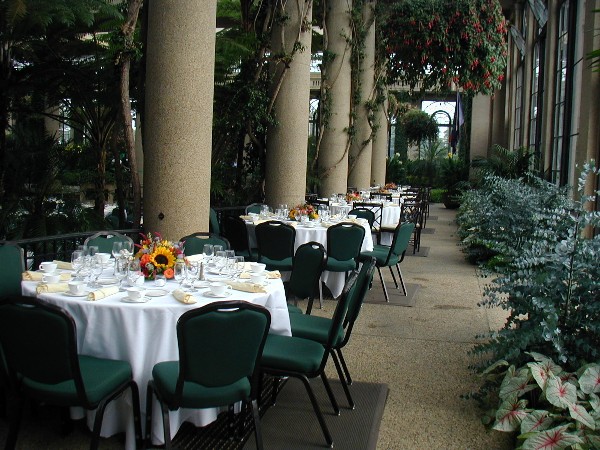
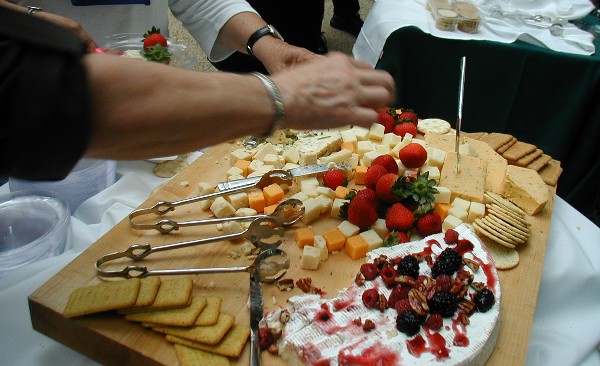
and the tasty nibbles accompanying these sampling stations included the most fabulous brie,
topped with glazed walnuts, blackberries, raspberries, and a swirl of raspberry sauce.
Can you tell how popular this was?
Just look at Barbara's delighted smile.
Our table kept it circling until there was nothing left, which didn't take very long at all.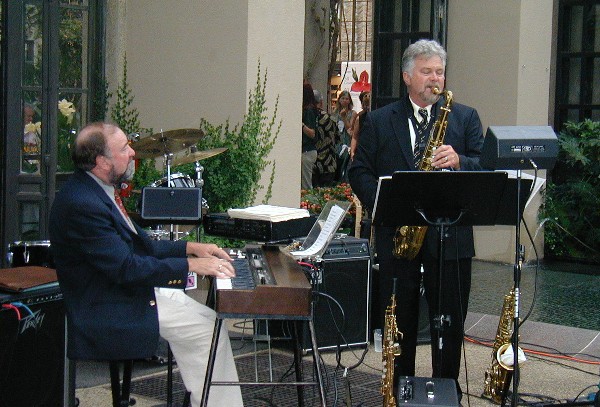
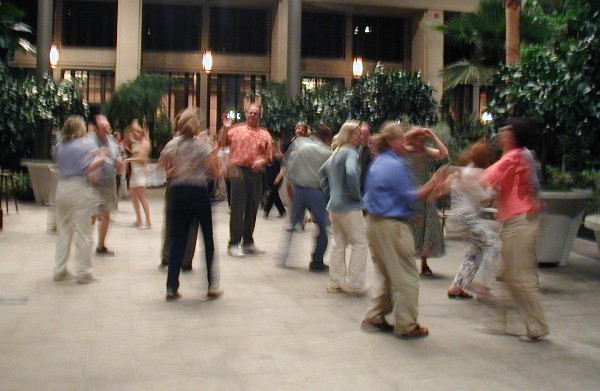
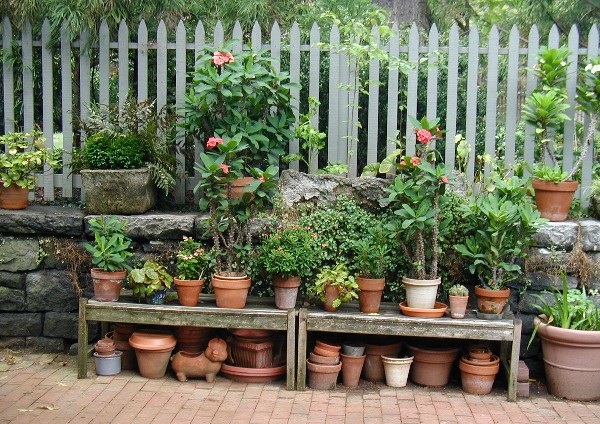
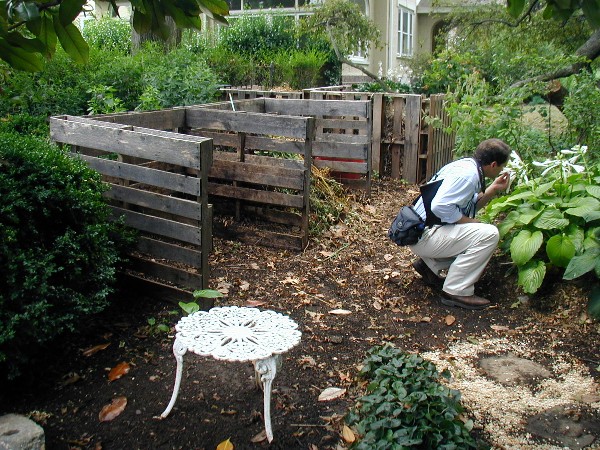
Chris Wiesinger, of Southern Bulbs enjoys the sweet fragrance of August lily, Hosta plantaginea. 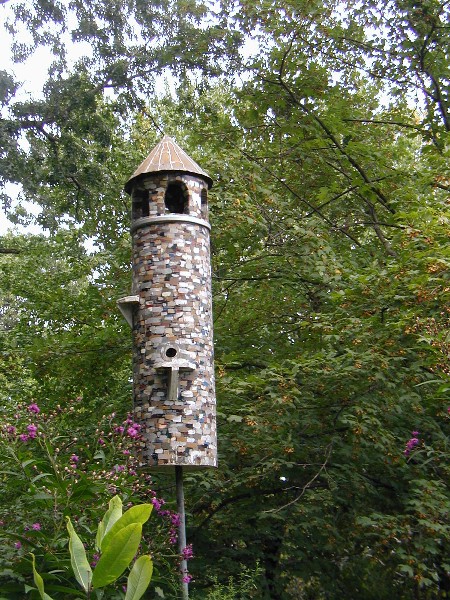
It was built by Thomas Frazer Burke of Castles in the Sky, in Wilmington.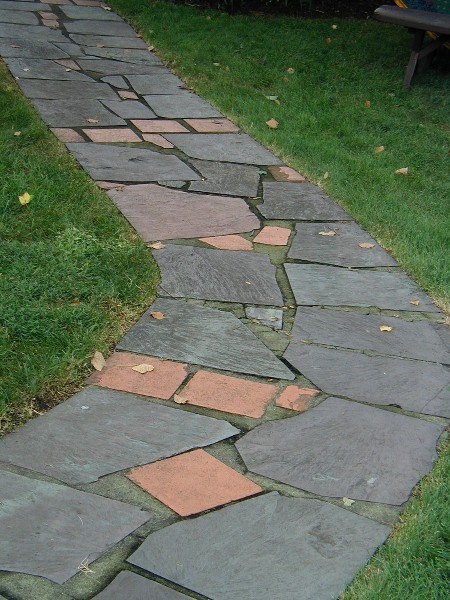
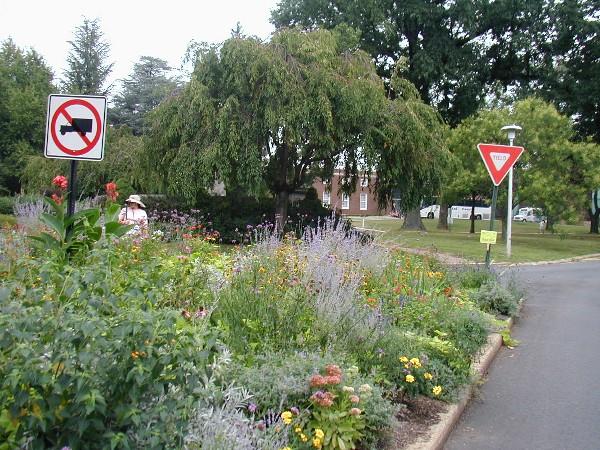
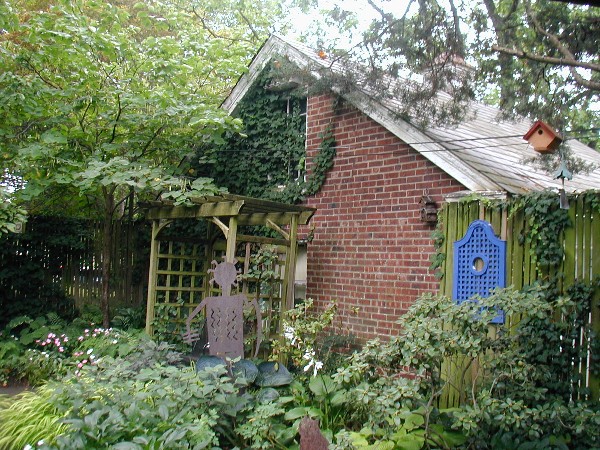
A brilliant blue grate hung on the fence, a sheet metal cat, and a dancer erupts from the plants.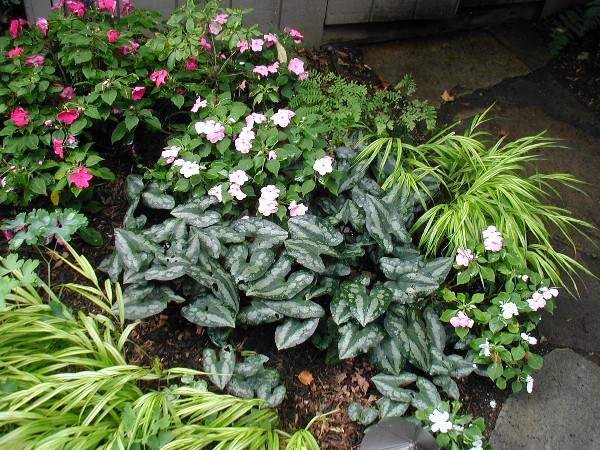
partnering with Japanese forest grass, Hakonechloa macra 'Aureola', and a scattering of impatiens.
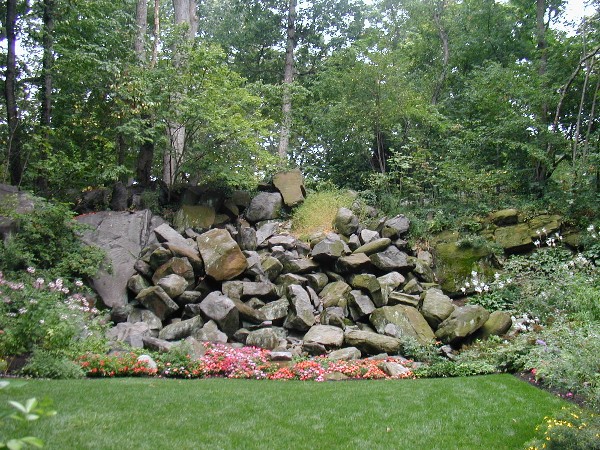
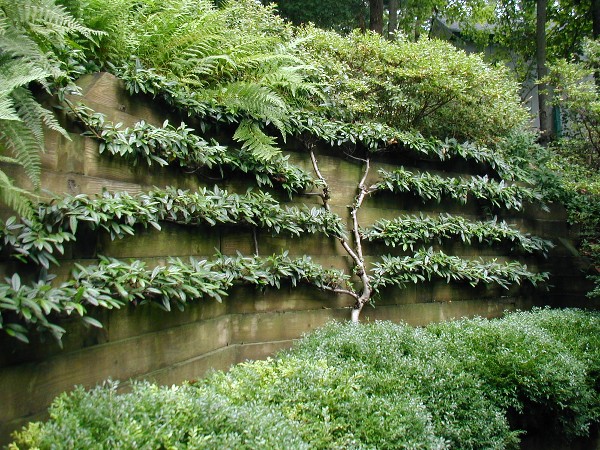
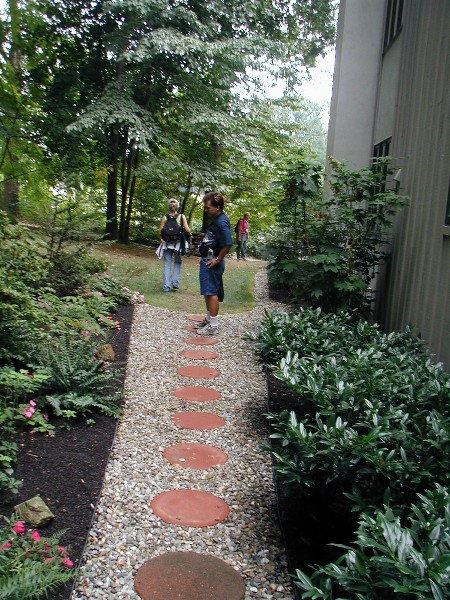
Crisp and tidy, a line of concrete stepping stones marching down the center of a gravel path.
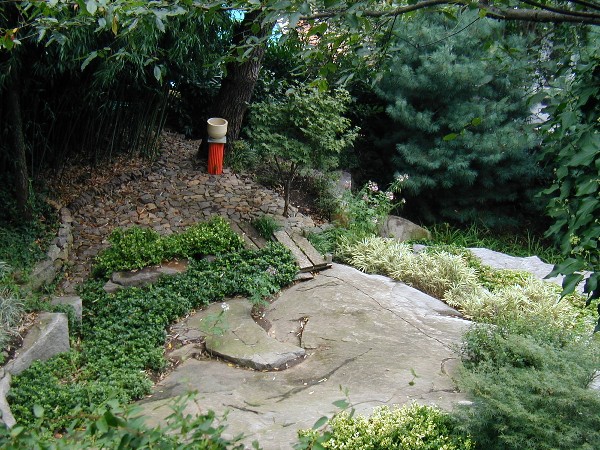
ornamented with a column made from piece of plastic scrap in Heian red.
A little zig-zag footbridge, confusing to bad spirits,
and a line of white striped bamboo implacably confined between the rocks.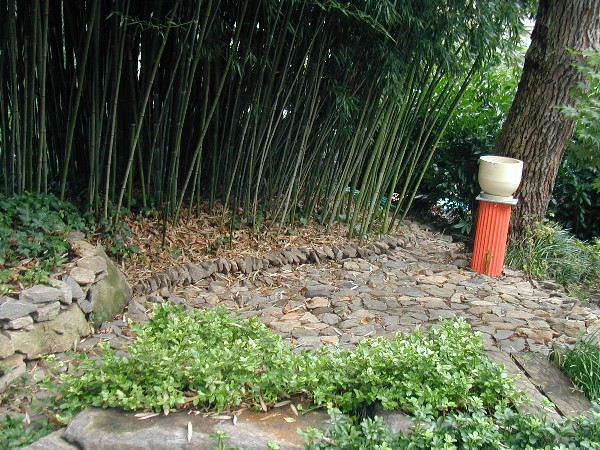
where details can be more closely observed and appreciated.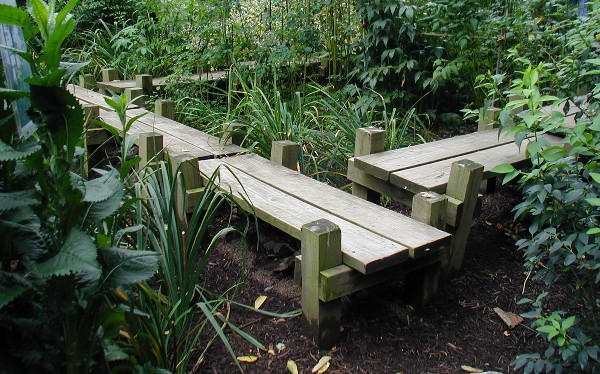
In spring, water sheets across the rock. And the charming, simple footbridge cum path offers a way to cross dry-shod.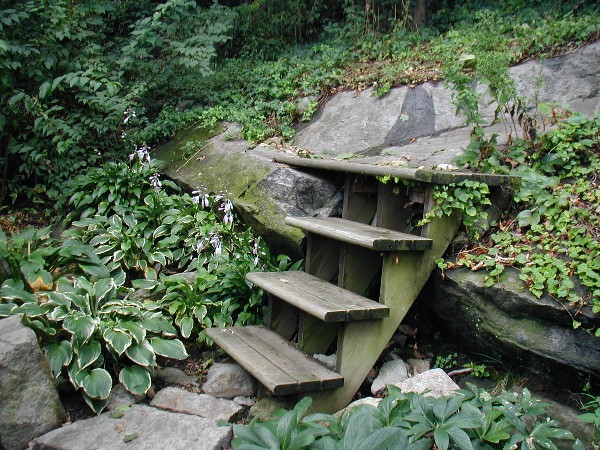
There comes a point when more is needed. A flight of steps, not much removed from ladder-dom, makes the connection.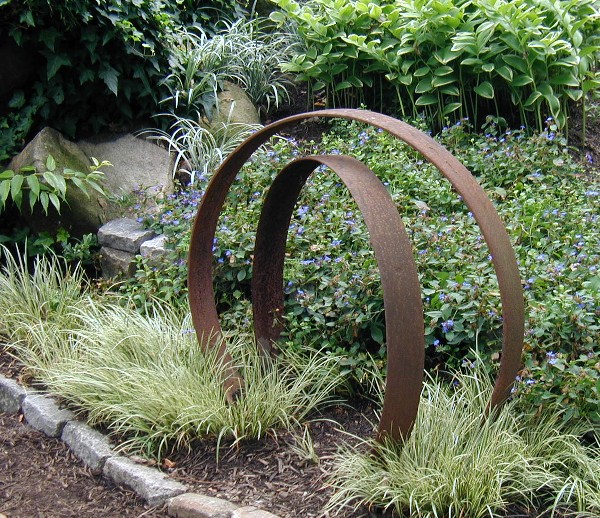
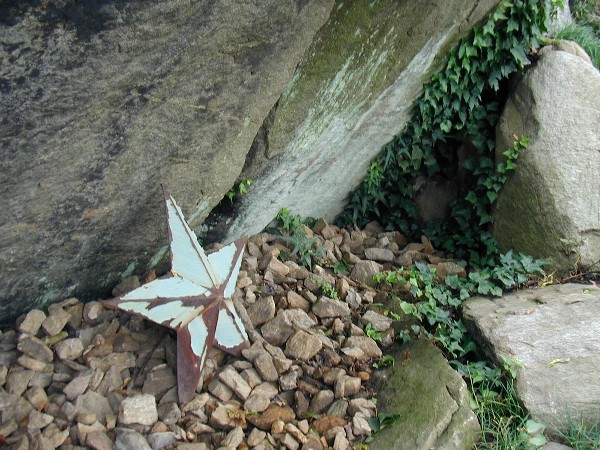
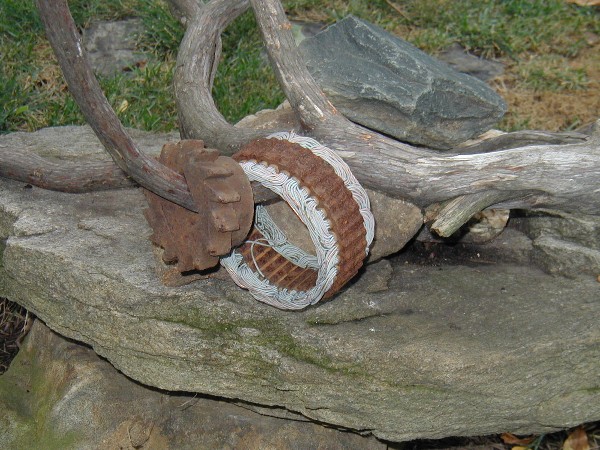
A piece of an electric motor, copper windings oxidized to verdigris and held within oxidized iron = rust.
Bound in wabi, simplicity and quietude and rustic beauty, both that made by nature, and that which is made by man.
Sabi, beauty from the patina of age, and shibui, a profound, unassuming and quiet feeling. 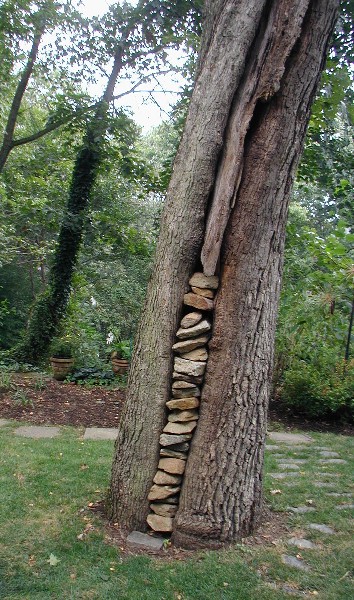
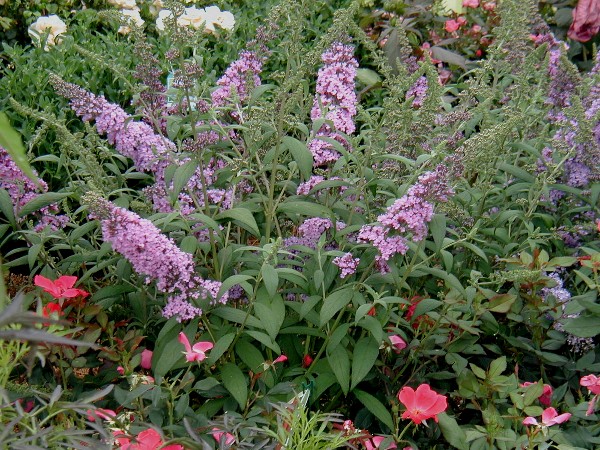
It will be a grand addition to the herbaceous border, mingling nicely with nearby perennials.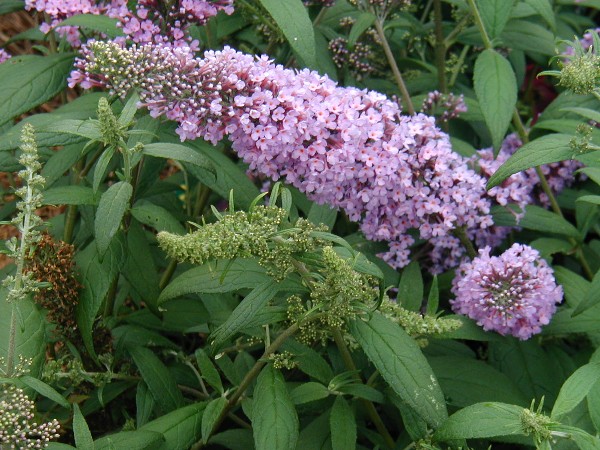
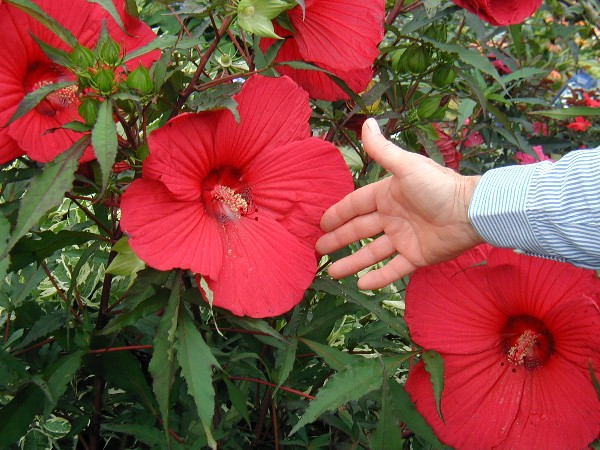
This hibiscus has flowers that are anything but. Just compare the size of the blossom to Rick's hand.
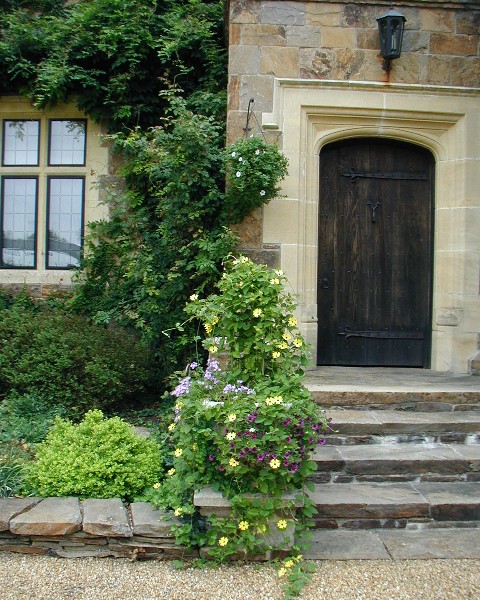
Once off the bus I stopped, as did many others, at the entry court and front door,
where a bountiful pot of black-eyed Susan vine, Thunbergia alata, spilled over the stone.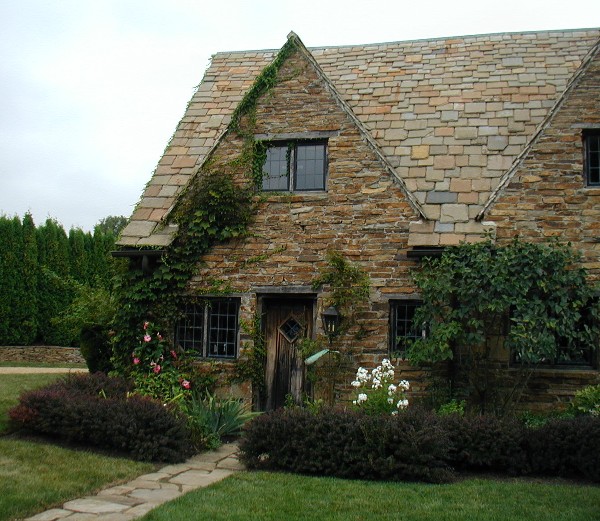
that it certainly looked good enough to live in, and the little entry garden wasn't bad either.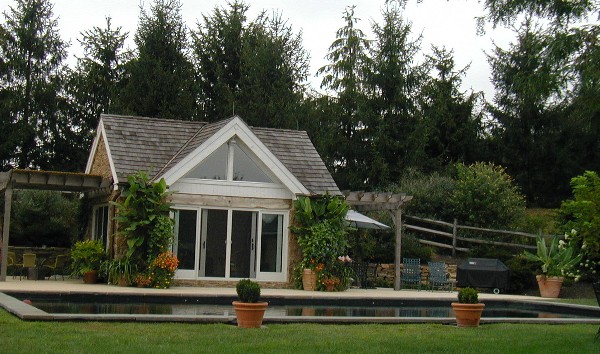

Stone steps were divided in an interesting manner, visually attractive and certain to appeal to roller-blading adolescents.
Designed by Rosemary Verey, it is clearly attractive to our group.
Notice the rustic arbors made from saplings, and the exquisite lead water tank in the corner.
There's a matching tank on the other side. 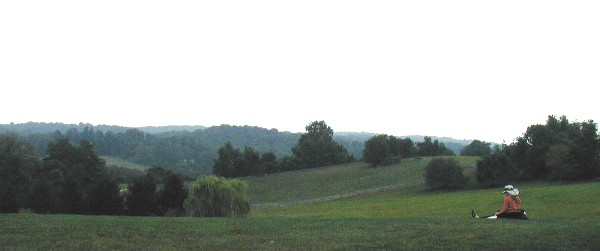
Garden artistry, she took out a little water color set, suitable for traveling, and dashed off a sketch.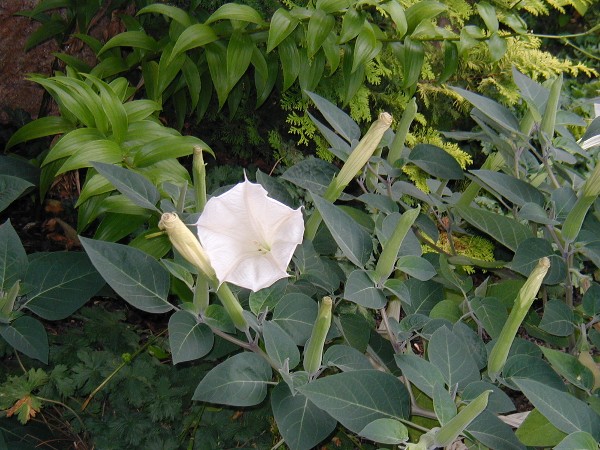
Doesn't this thorn apple, Datura species, look just elegant.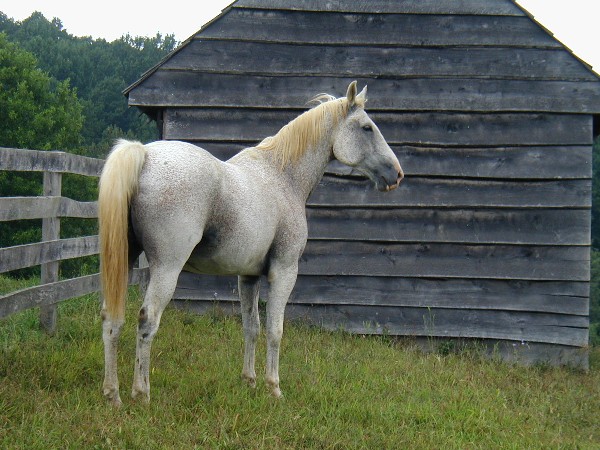
picking up his feet in dressage-like grace, then stop and pose so I could admire him.
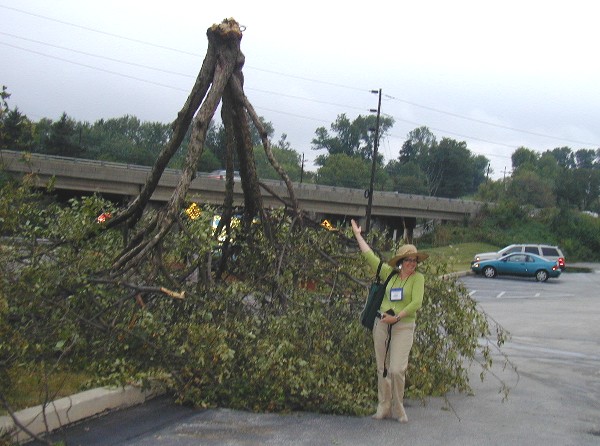
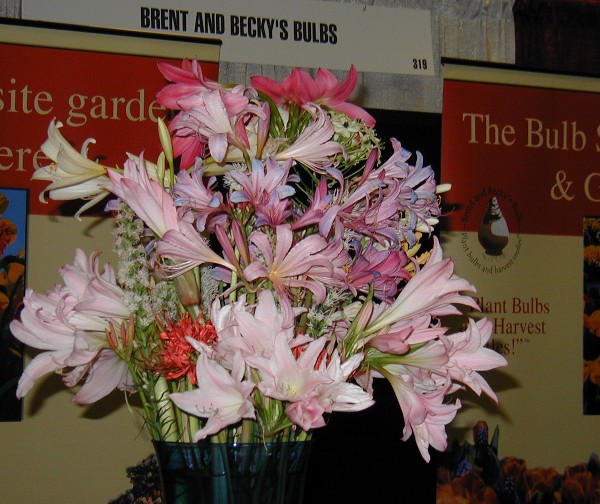

Another year, a different conference. Take another look at some of the same gardens,
and peek at different ones, all displaying the horticultural riches of the Philadelphia region.